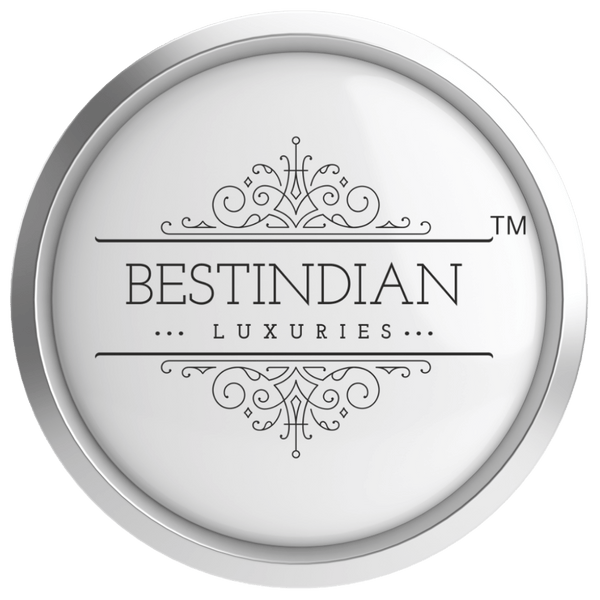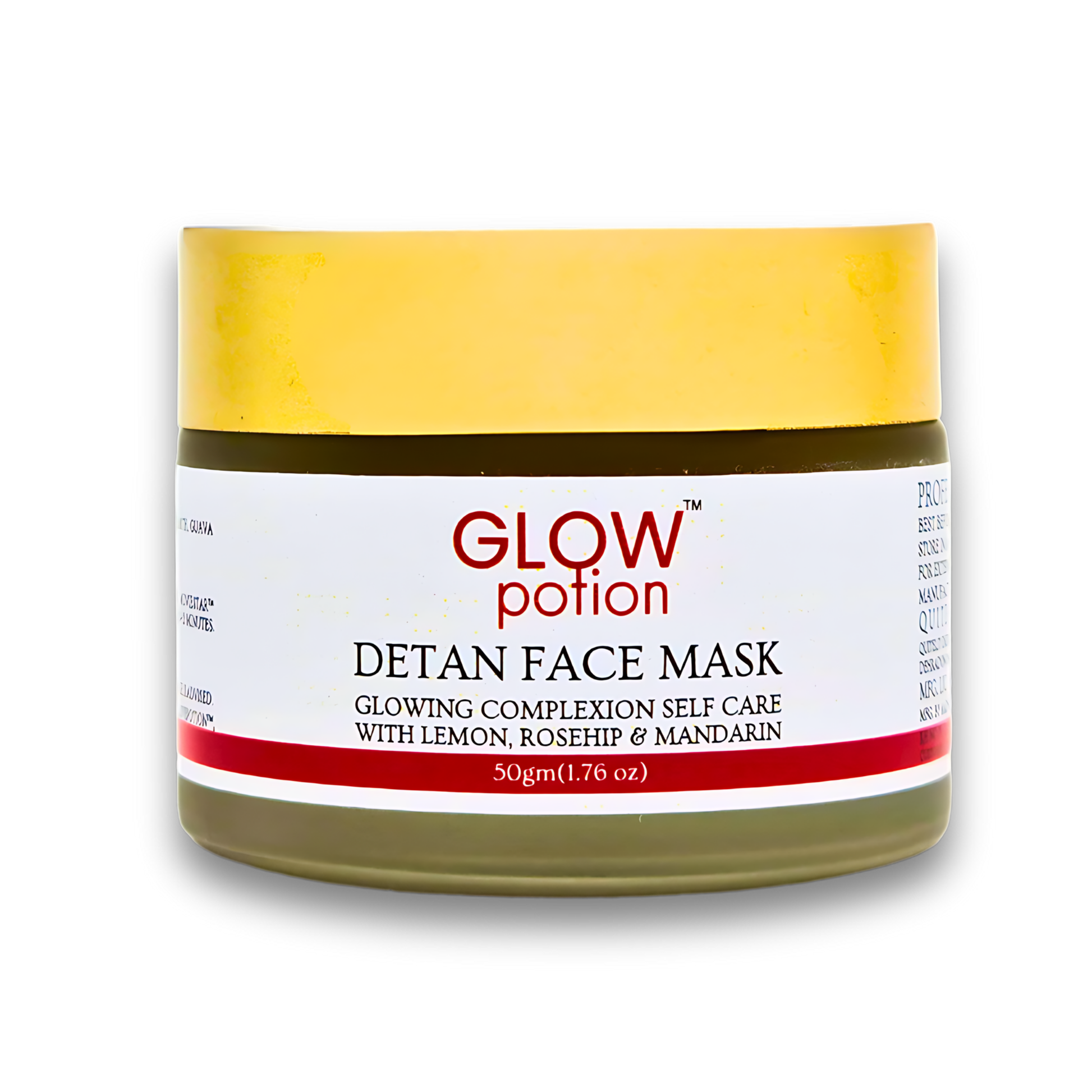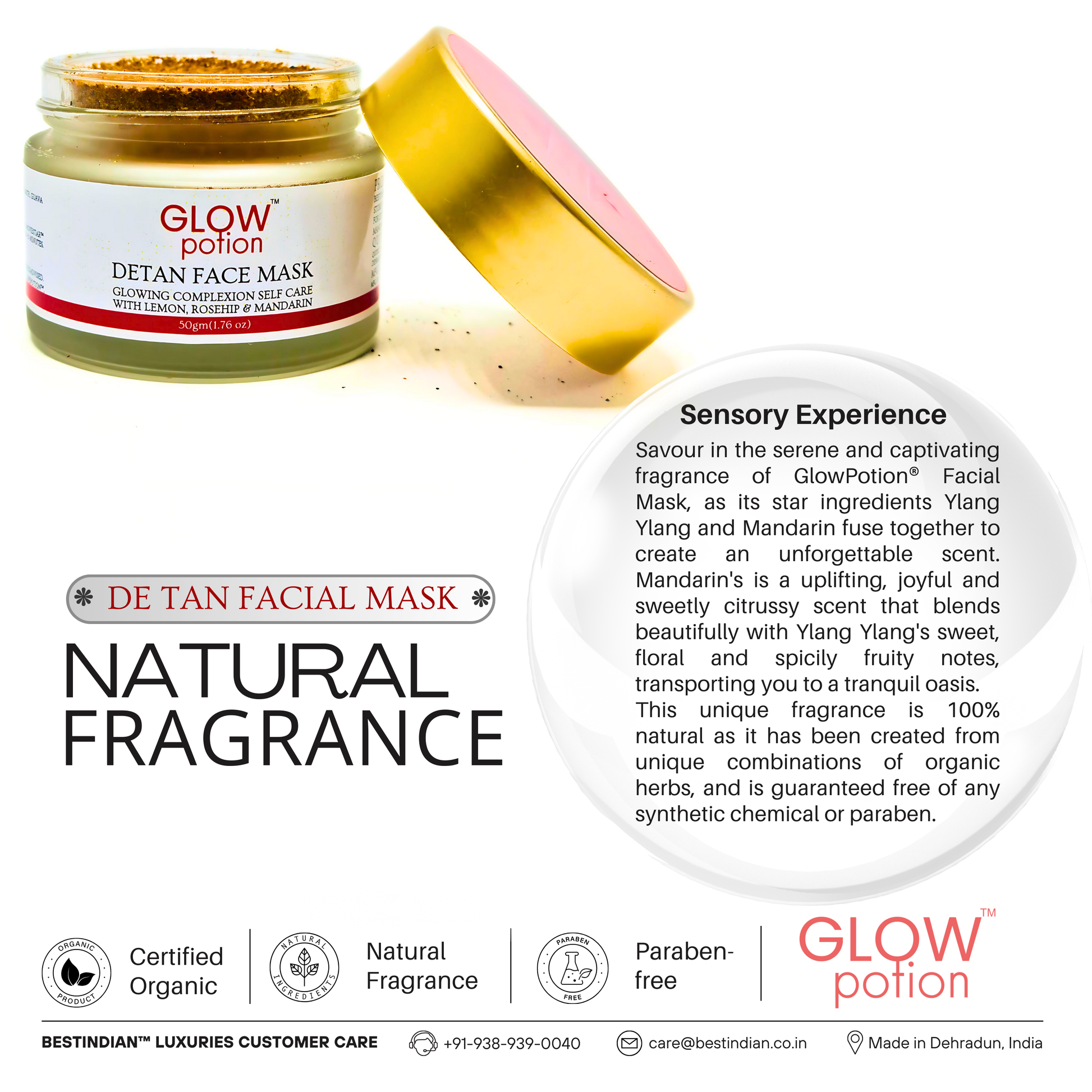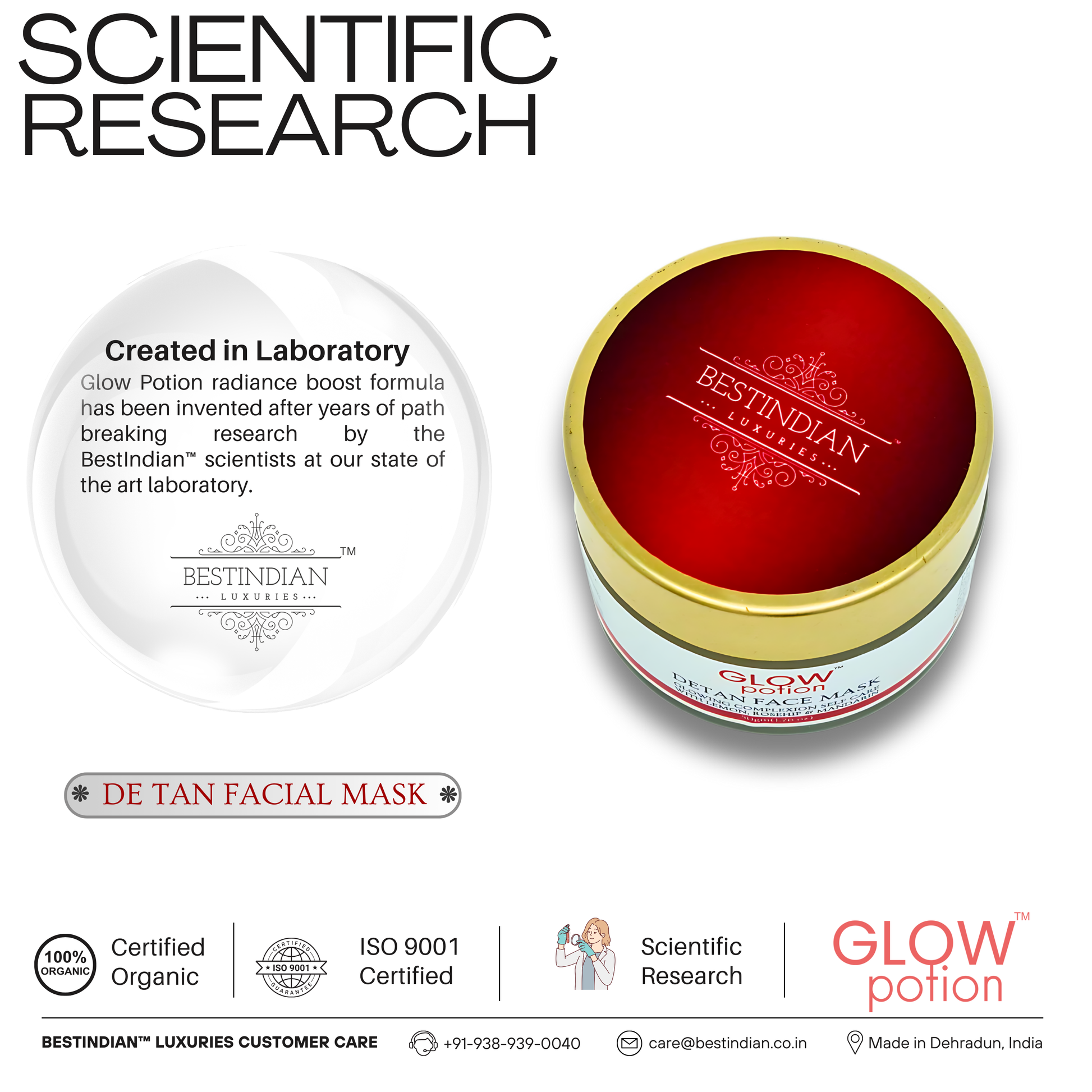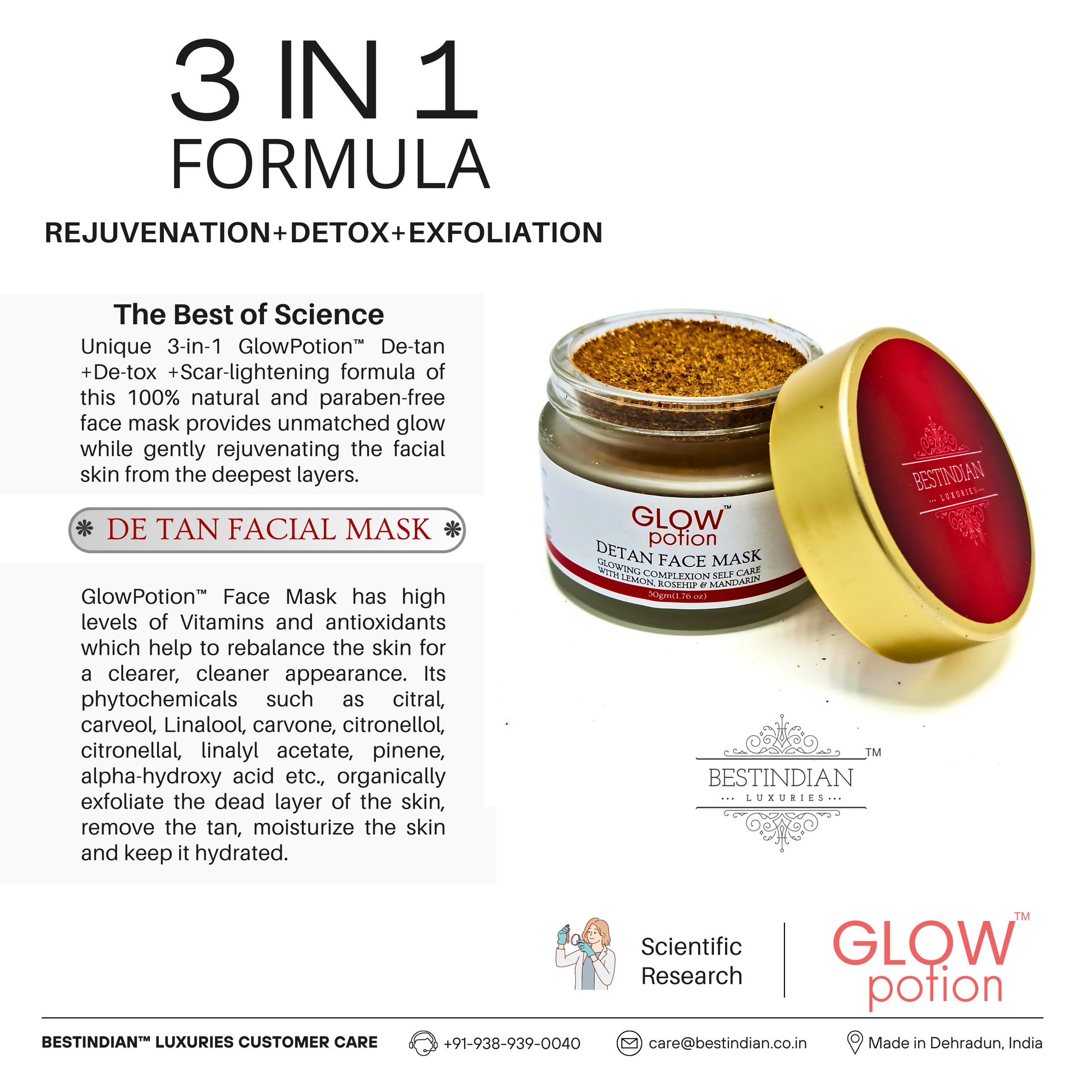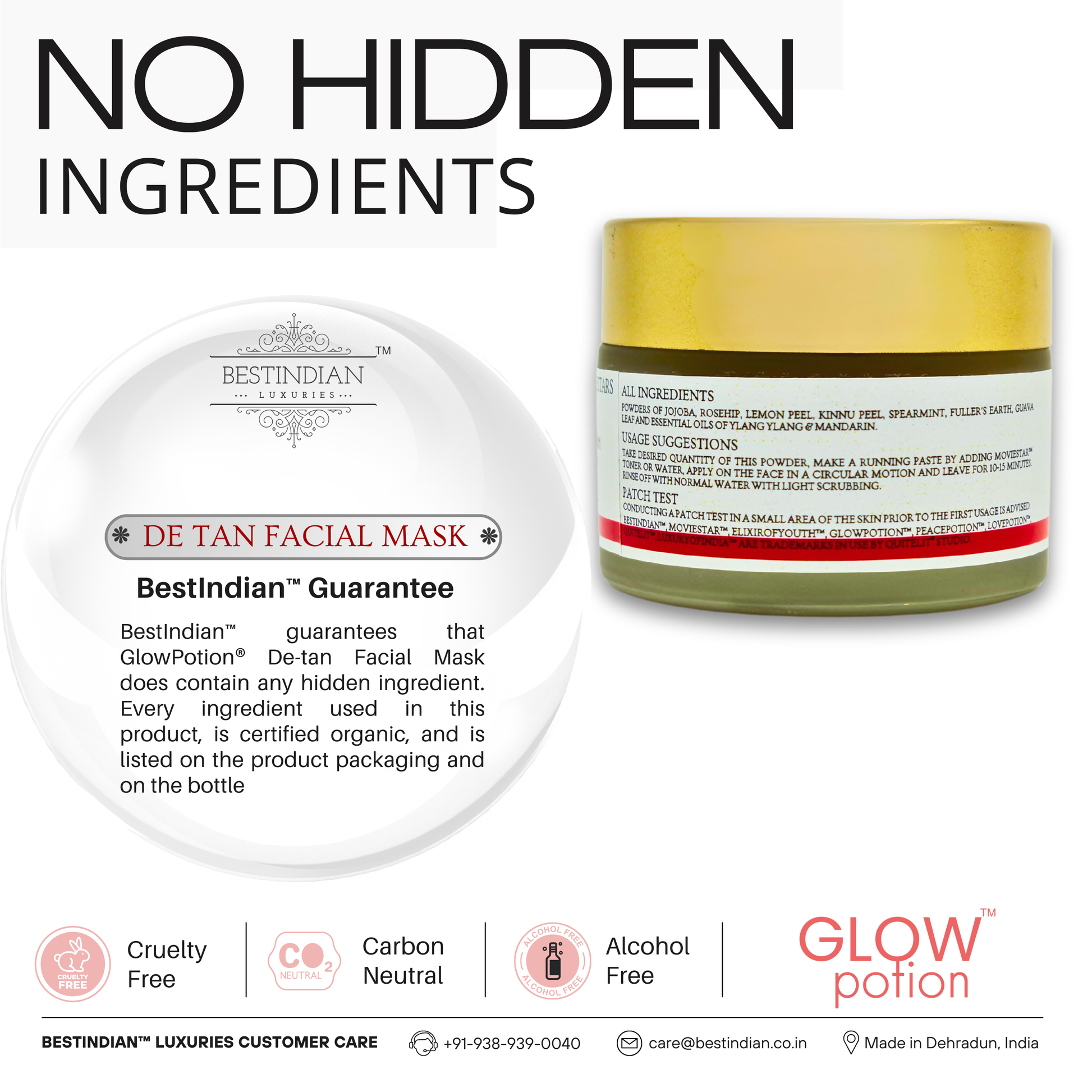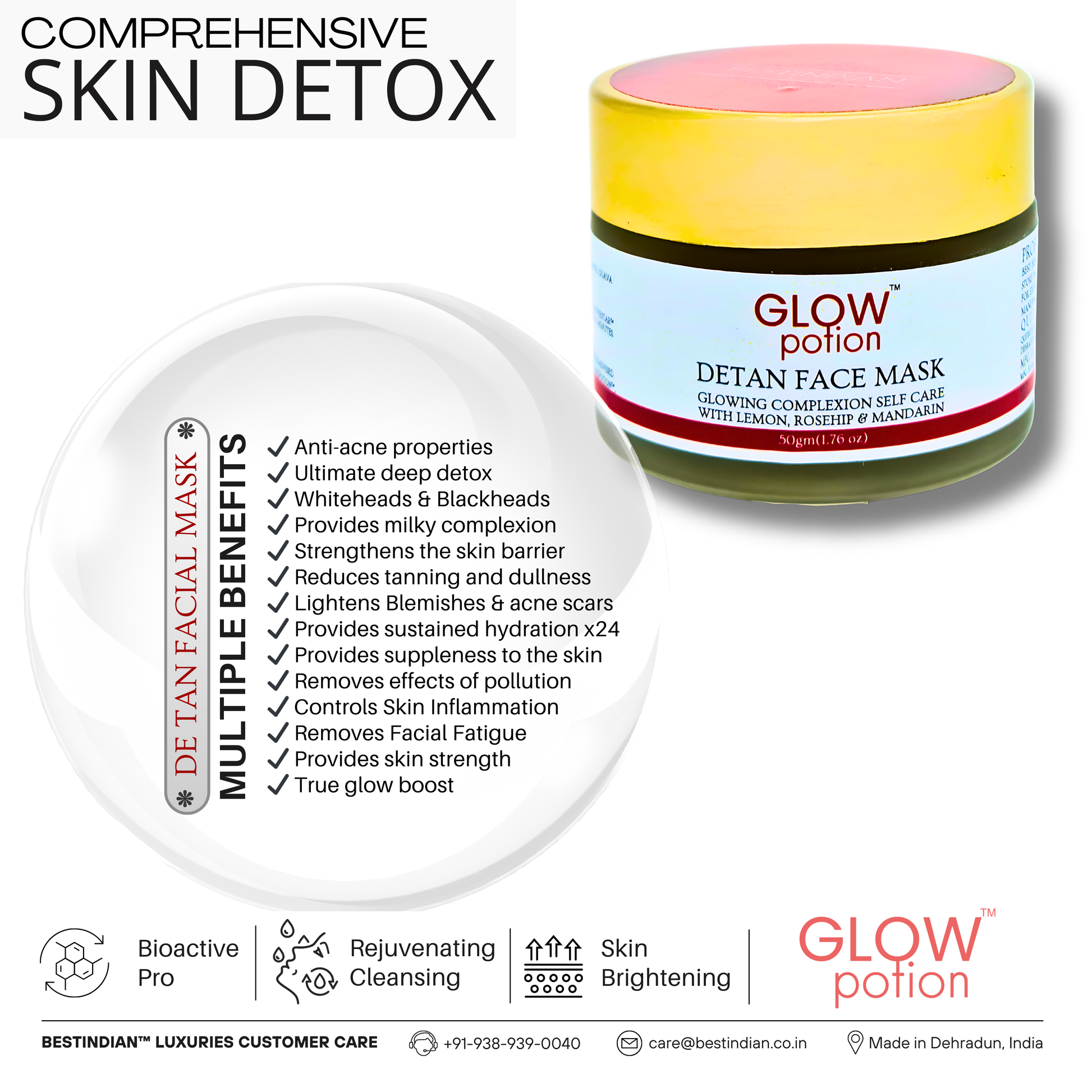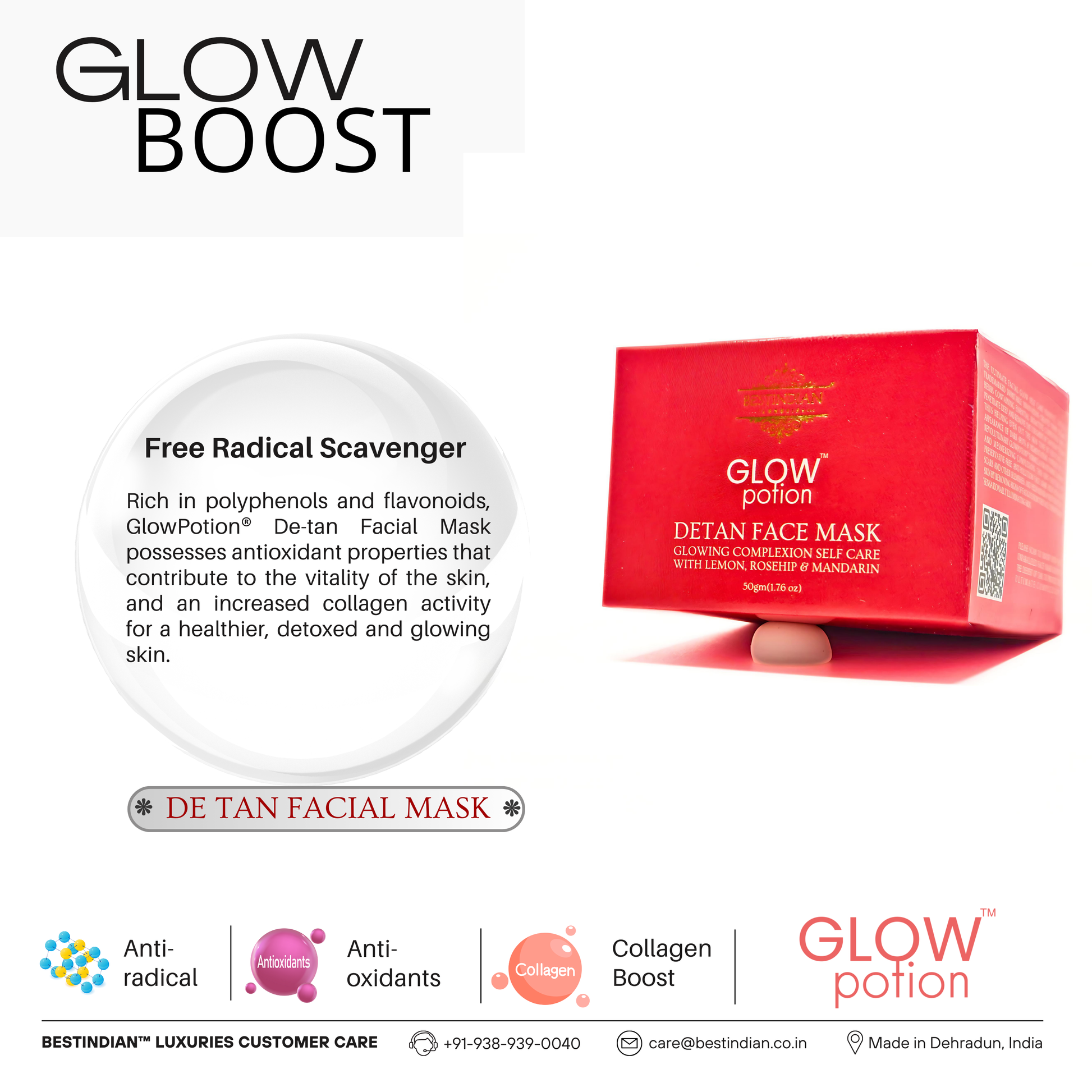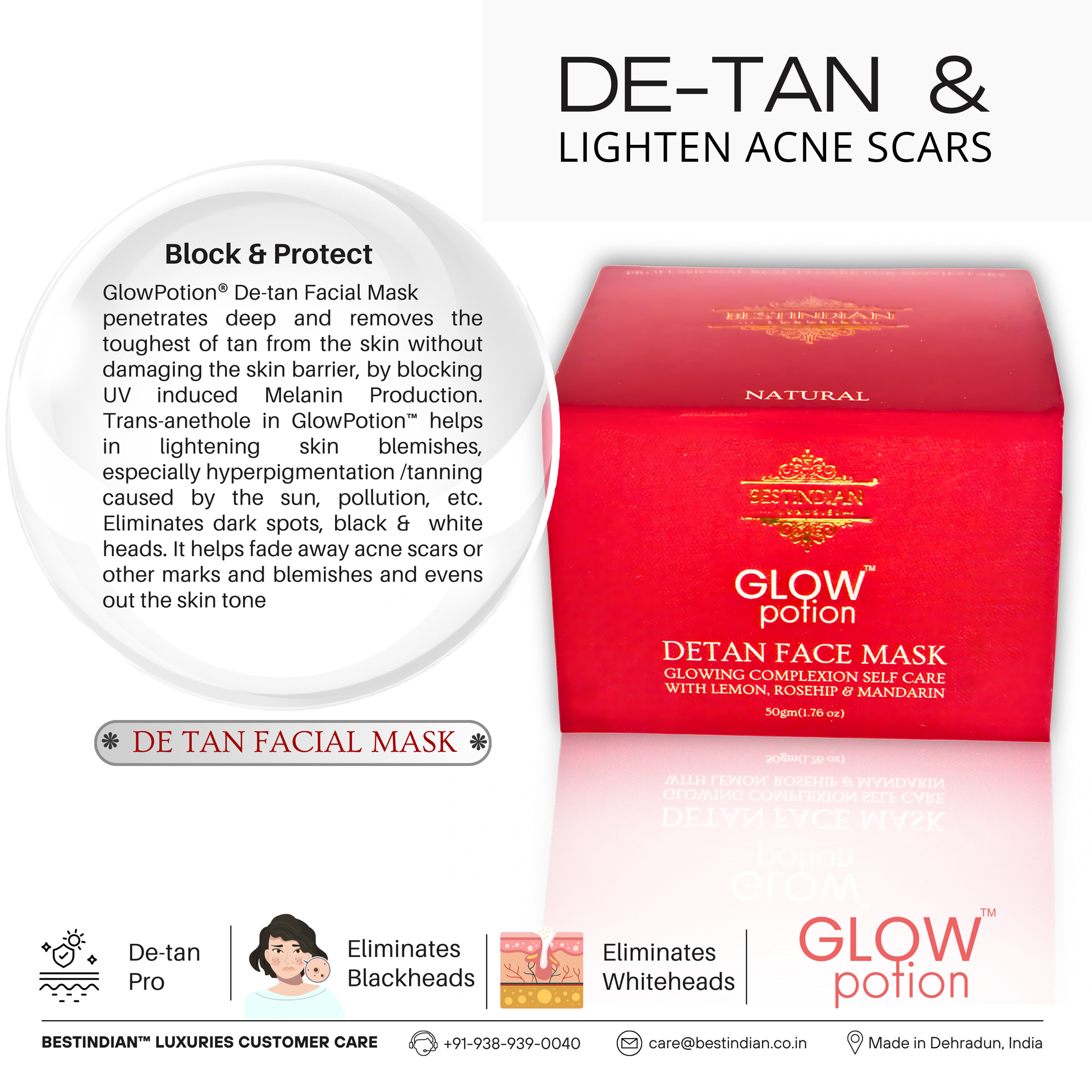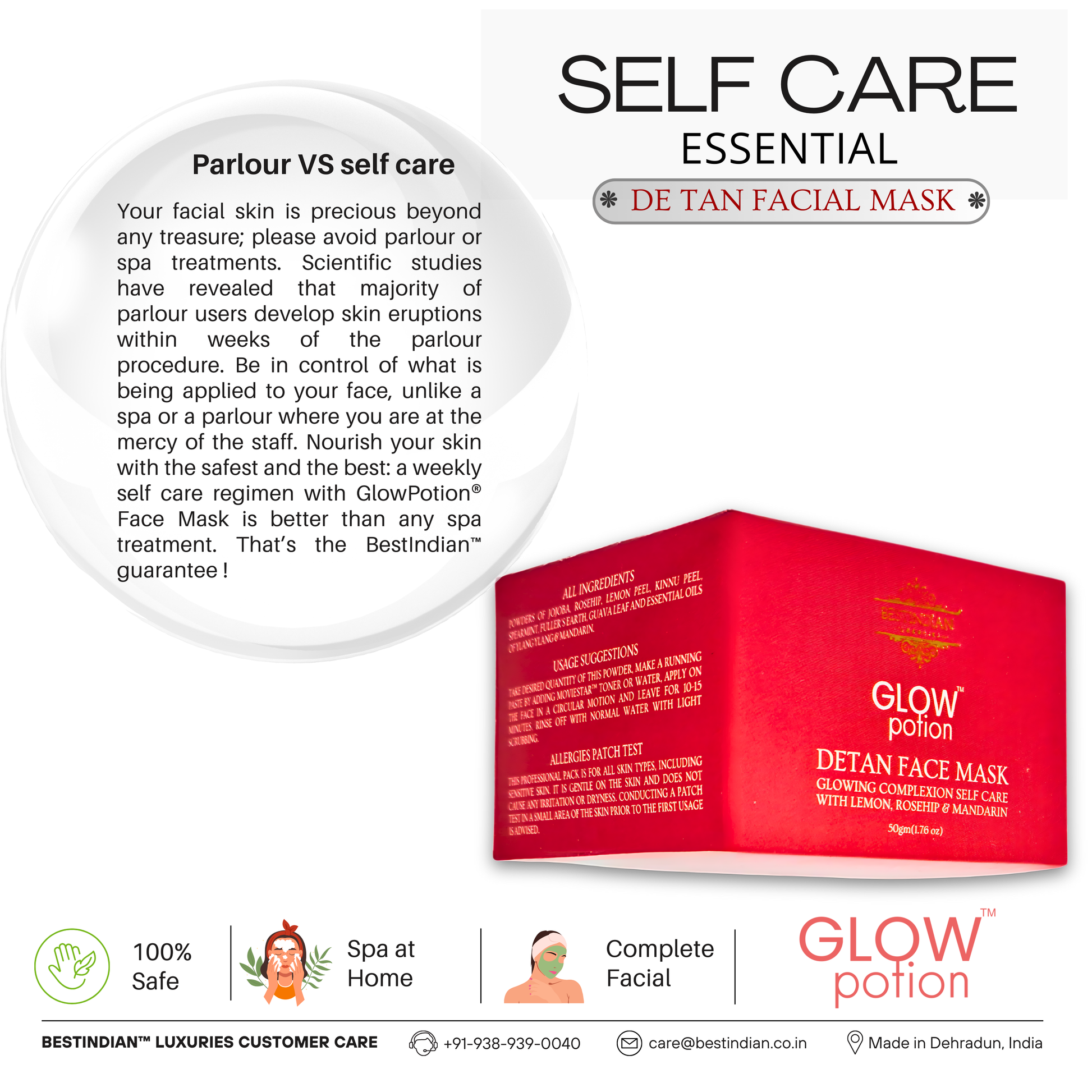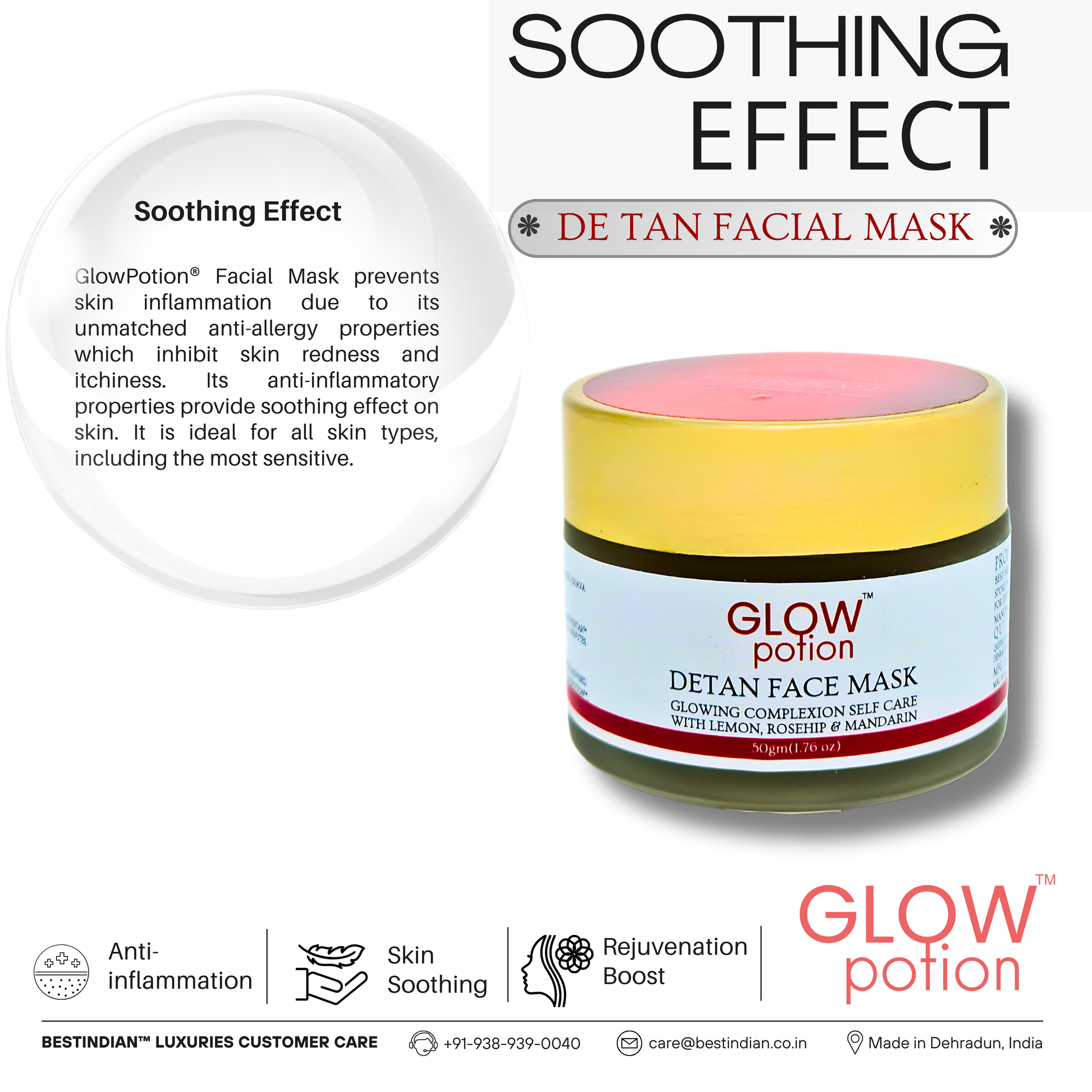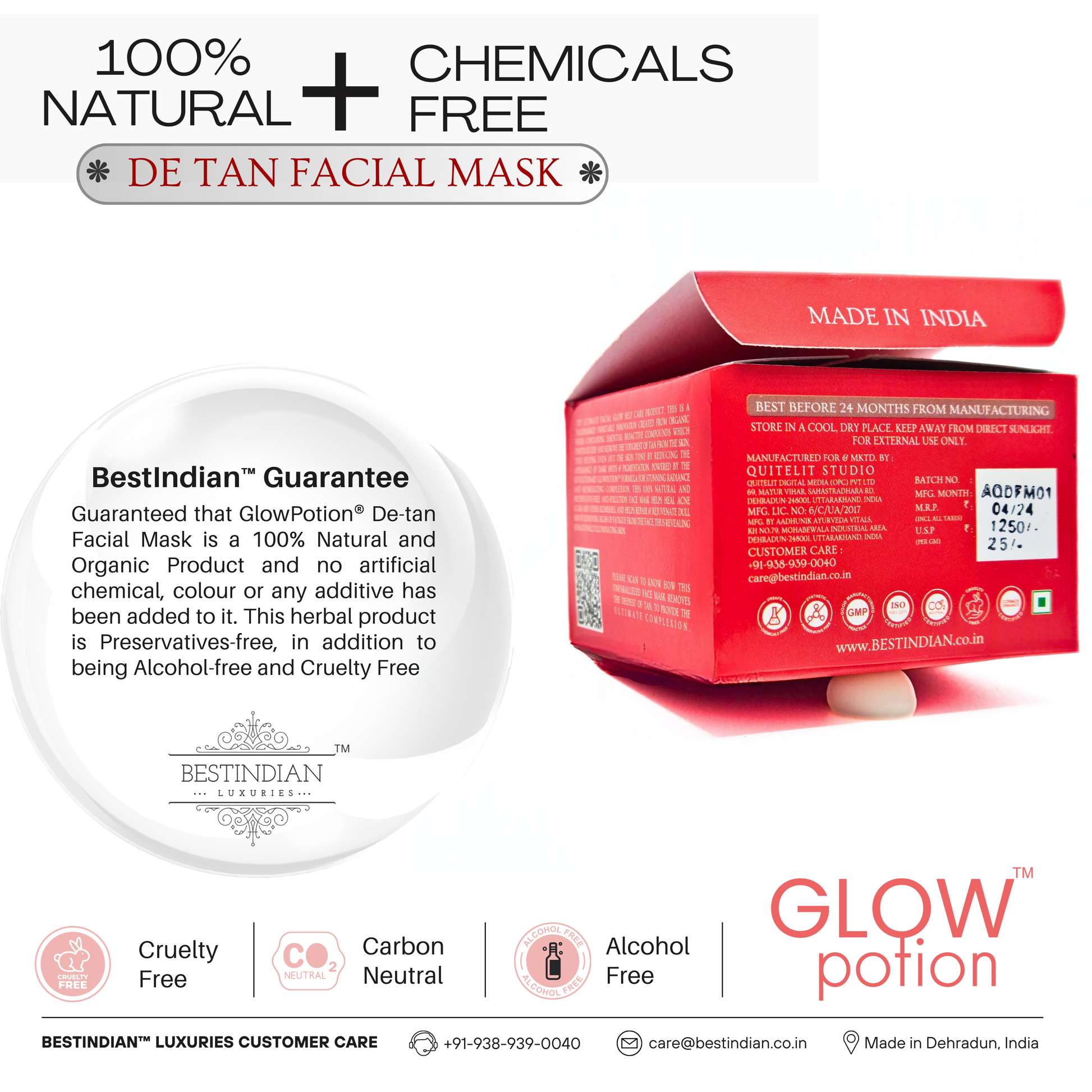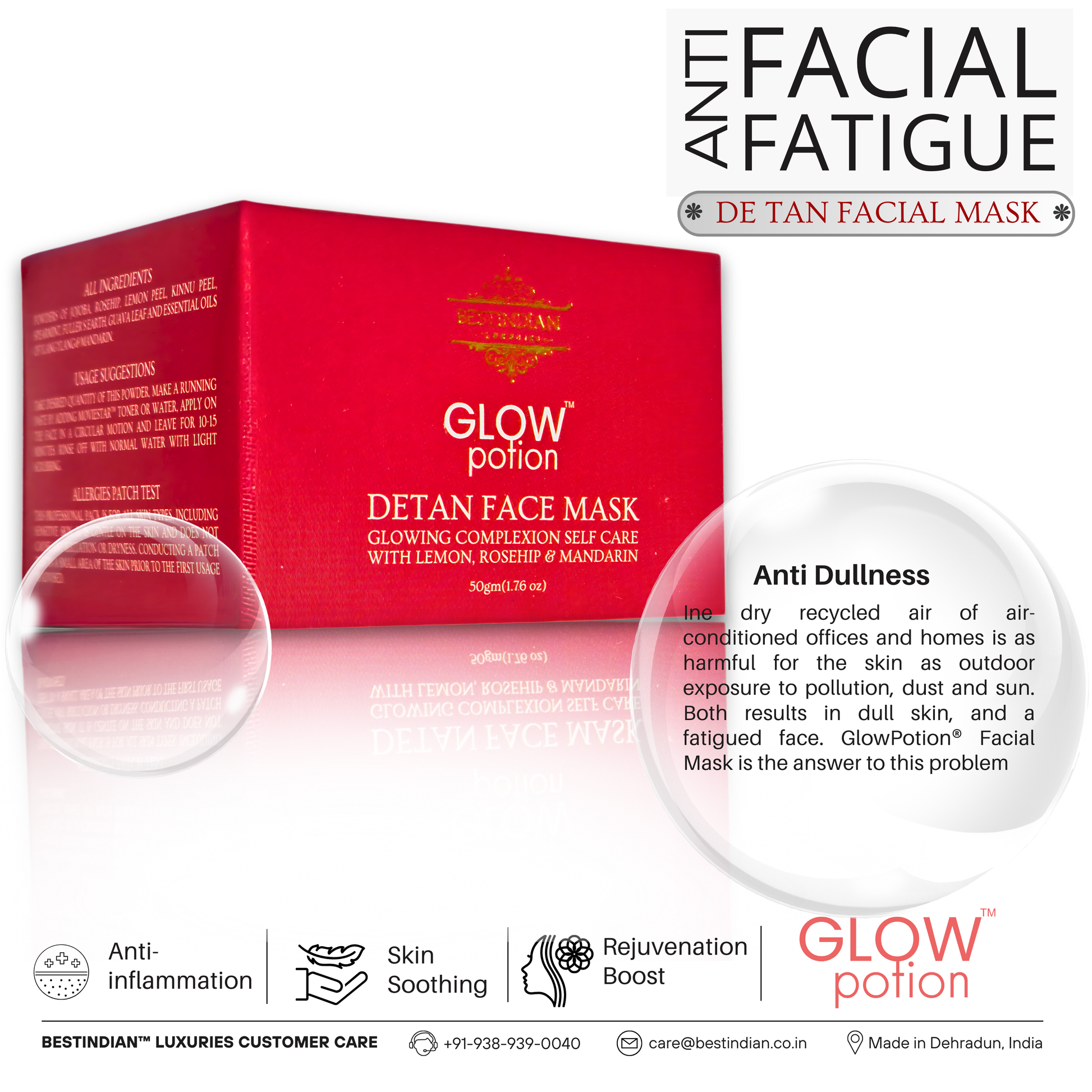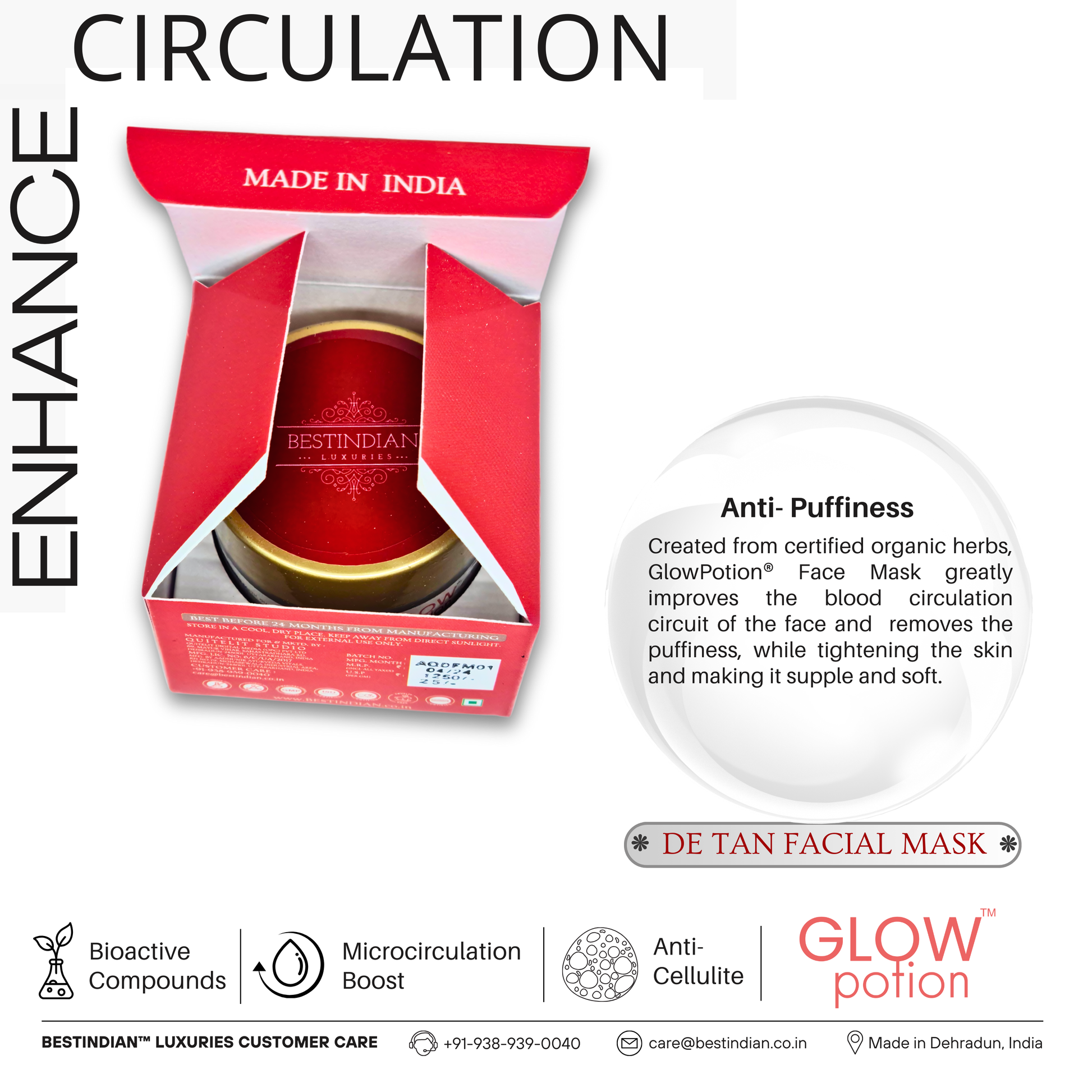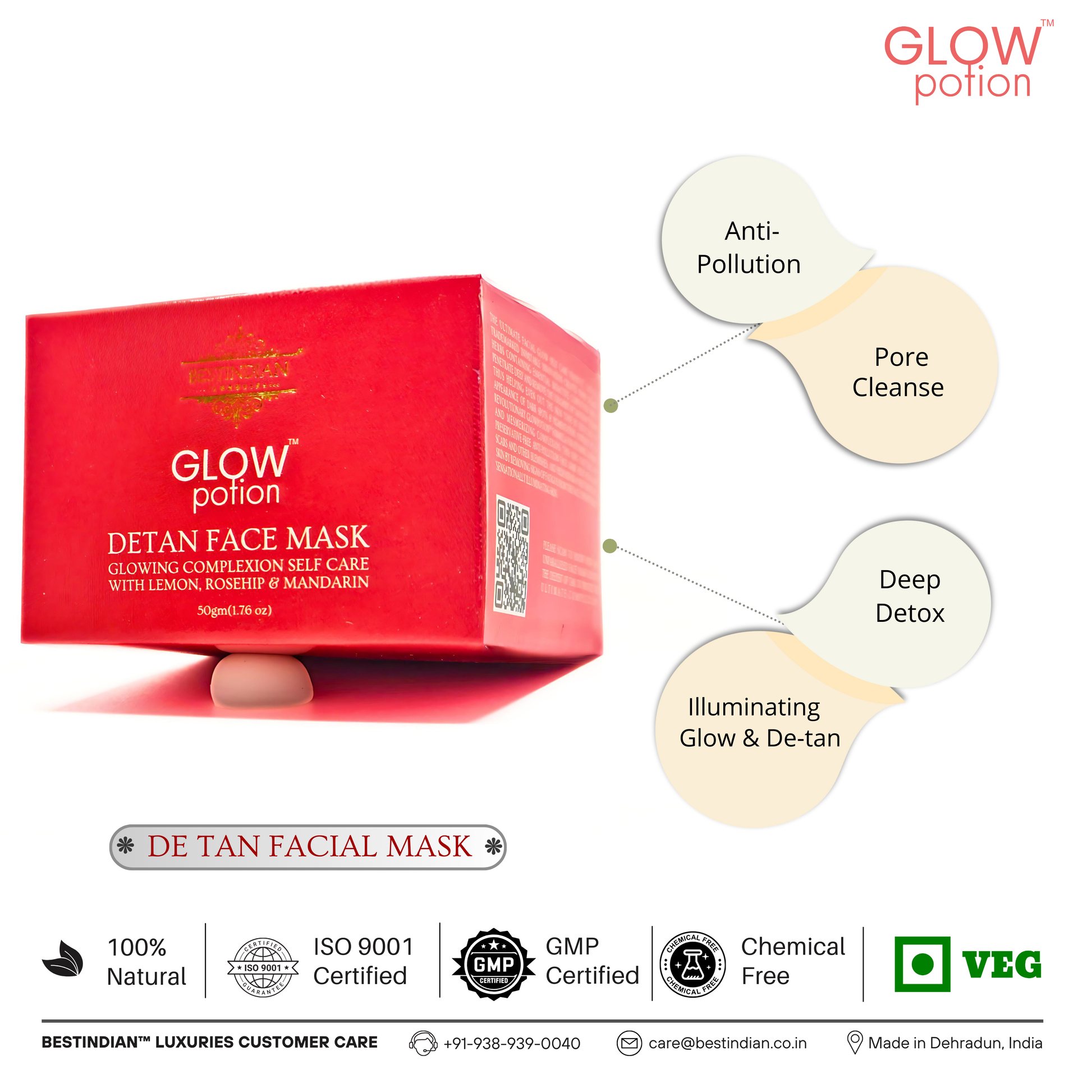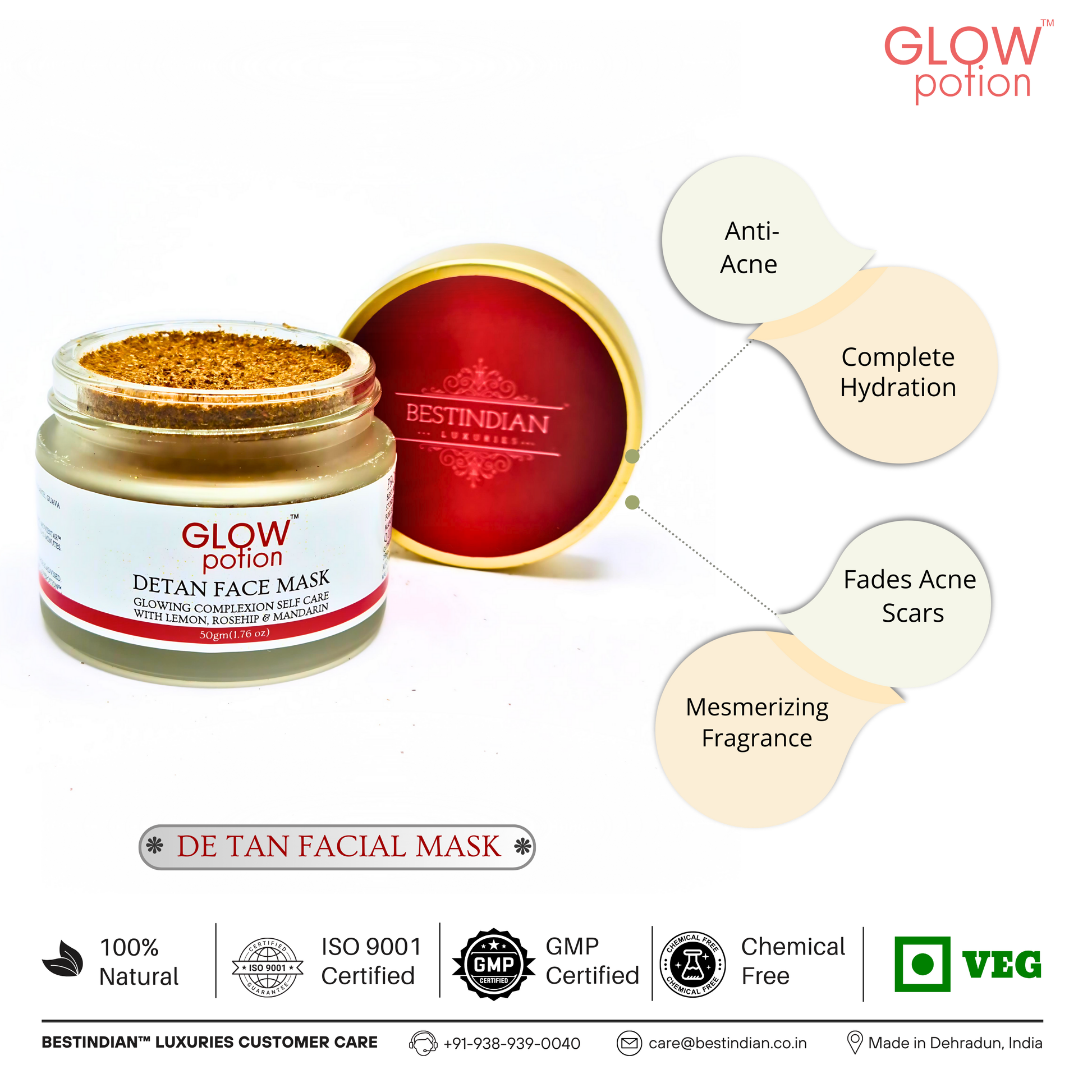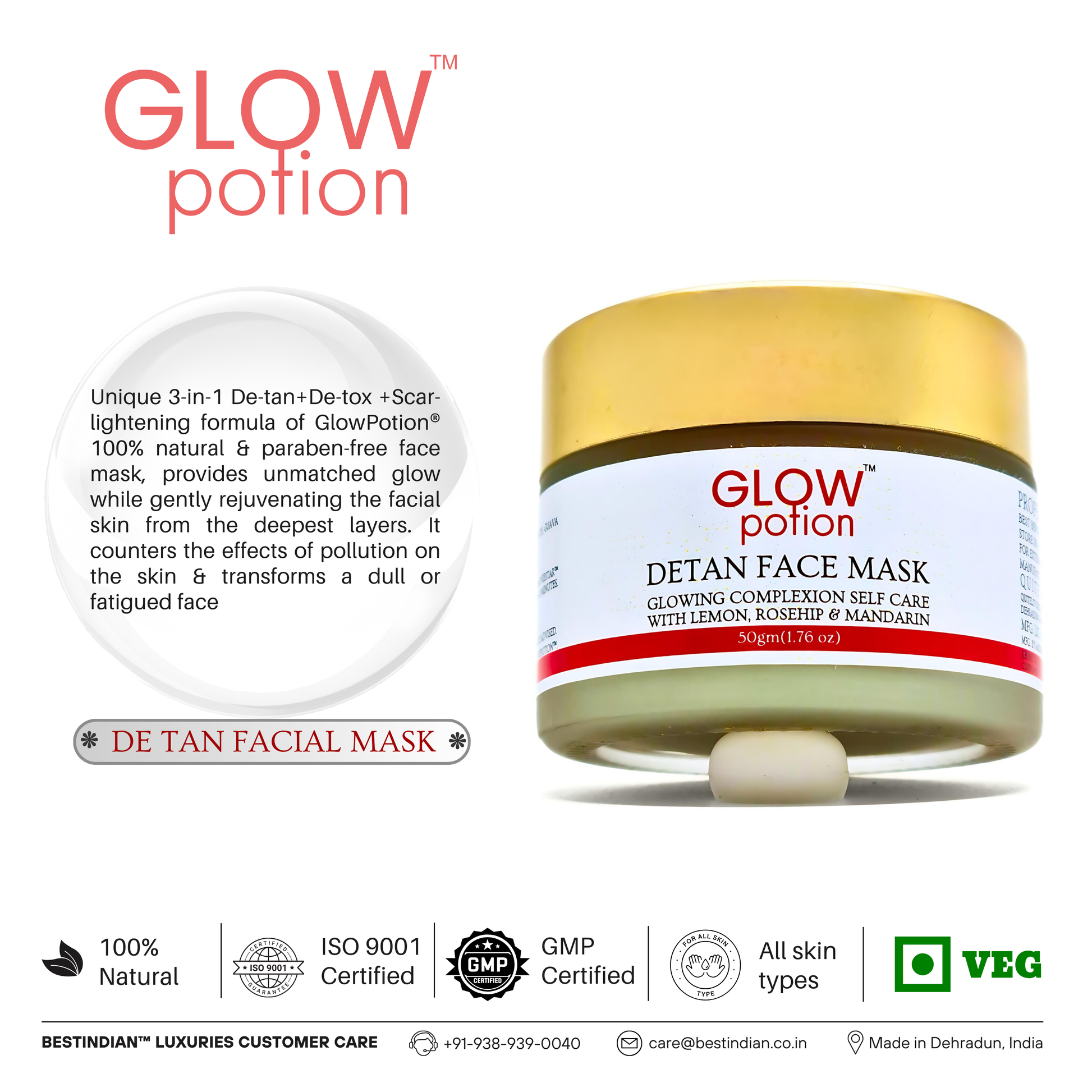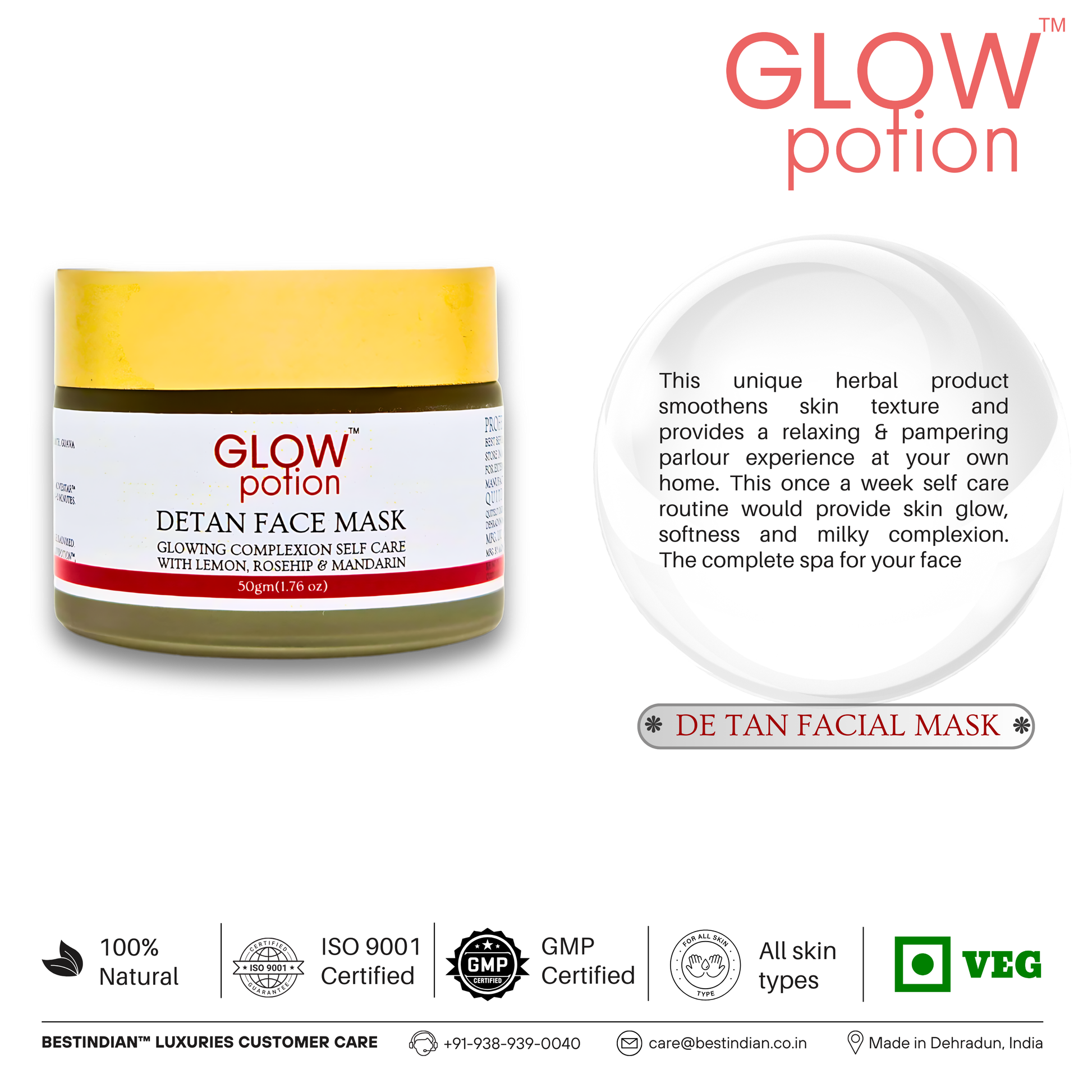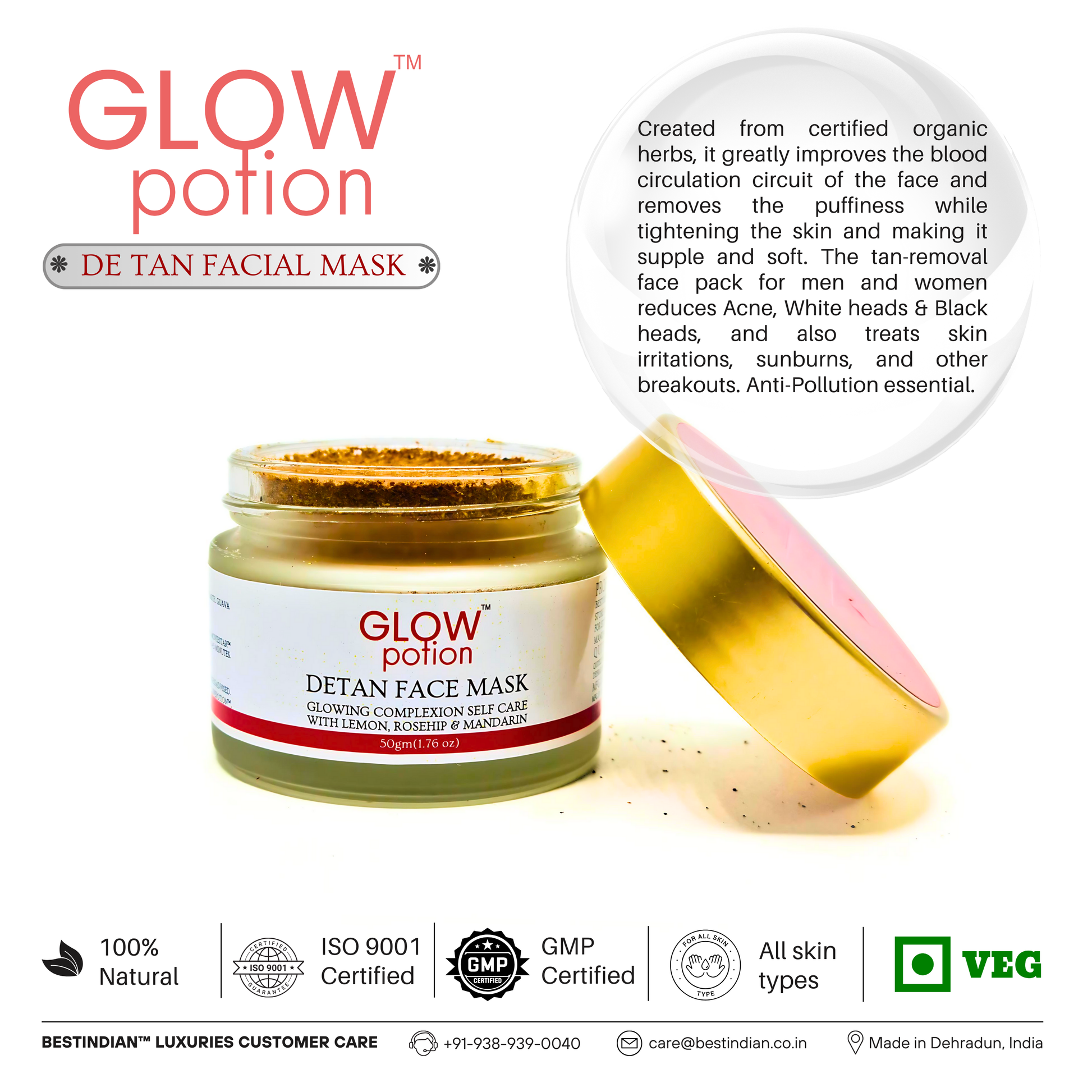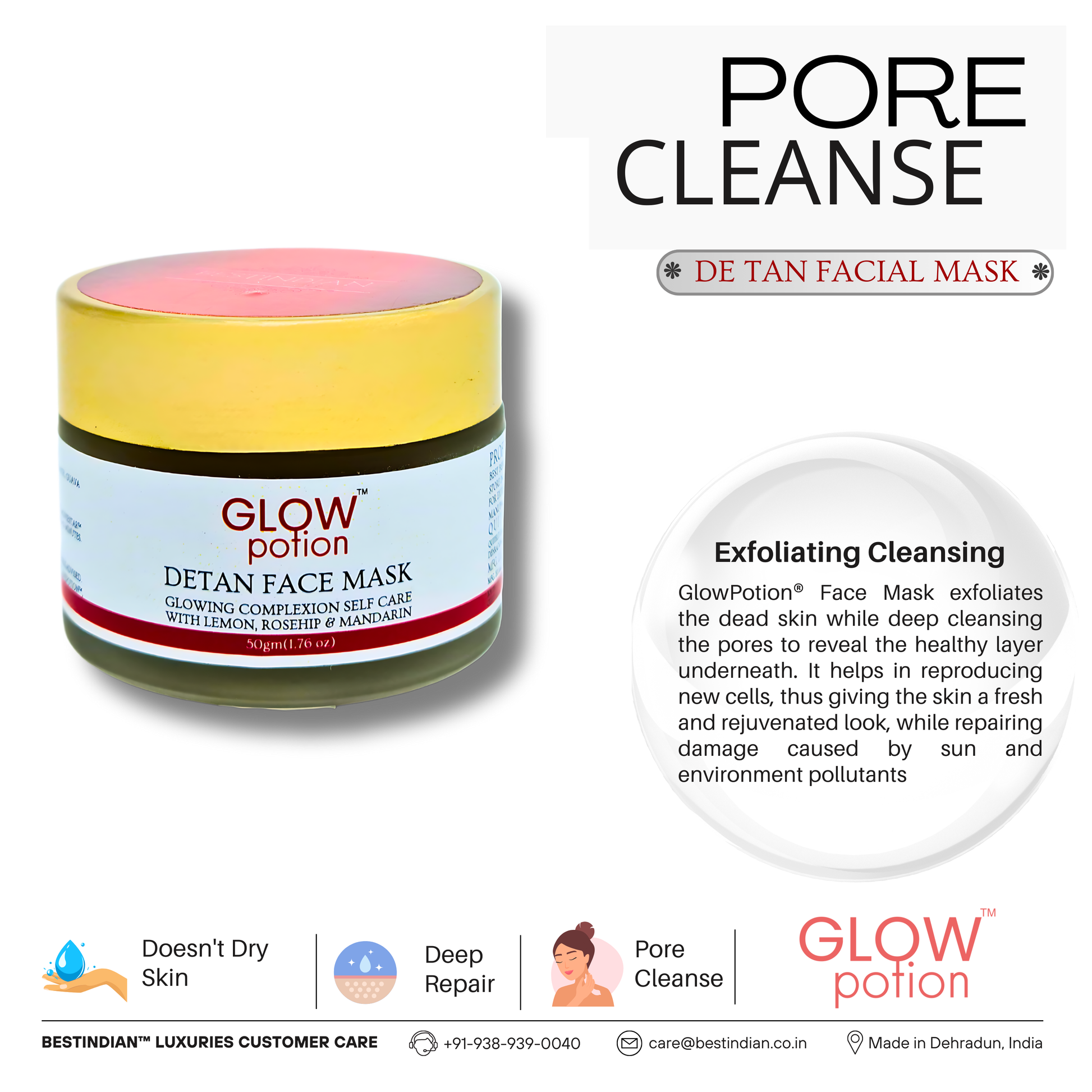BestIndian
GlowPotion™ De-Tan Face Mask: The Best Indian Face Pack for Tan Removal & Glowing Skin
GlowPotion™ De-Tan Face Mask: The Best Indian Face Pack for Tan Removal & Glowing Skin
Couldn't load pickup availability
Unveil your skin’s true radiance. This is the ultimate weekly ritual to reset your complexion, a powerful de tan face pack that works on three levels to restore a flawless glow. Our unique 3-in-1 formula is a potent blend of detoxifying clays and Ayurvedic herbs, designed to effectively remove the appearance of stubborn tan, purify pores, and lighten the look of blemishes and scars. This natural face mask is your at-home solution for the clear, bright, and rejuvenated skin you deserve.
A 3-in-1 Ayurvedic de-tan face pack that removes tan, detoxifies pores, and visibly lightens scars for a spectacular glow.
100% Natural • Preservative-Free • Ayurvedic Formula • For All Skin Types
Please Note: Conscious Archive Item (60% Off)
- Manufacturing Date: April 2024
- Best Before: April 2026
- This item is part of our Conscious Archive Sale and is offered at an exceptional 60% discount due to its approaching best before date. It is final sale.

DETAN FACE MASK
Share
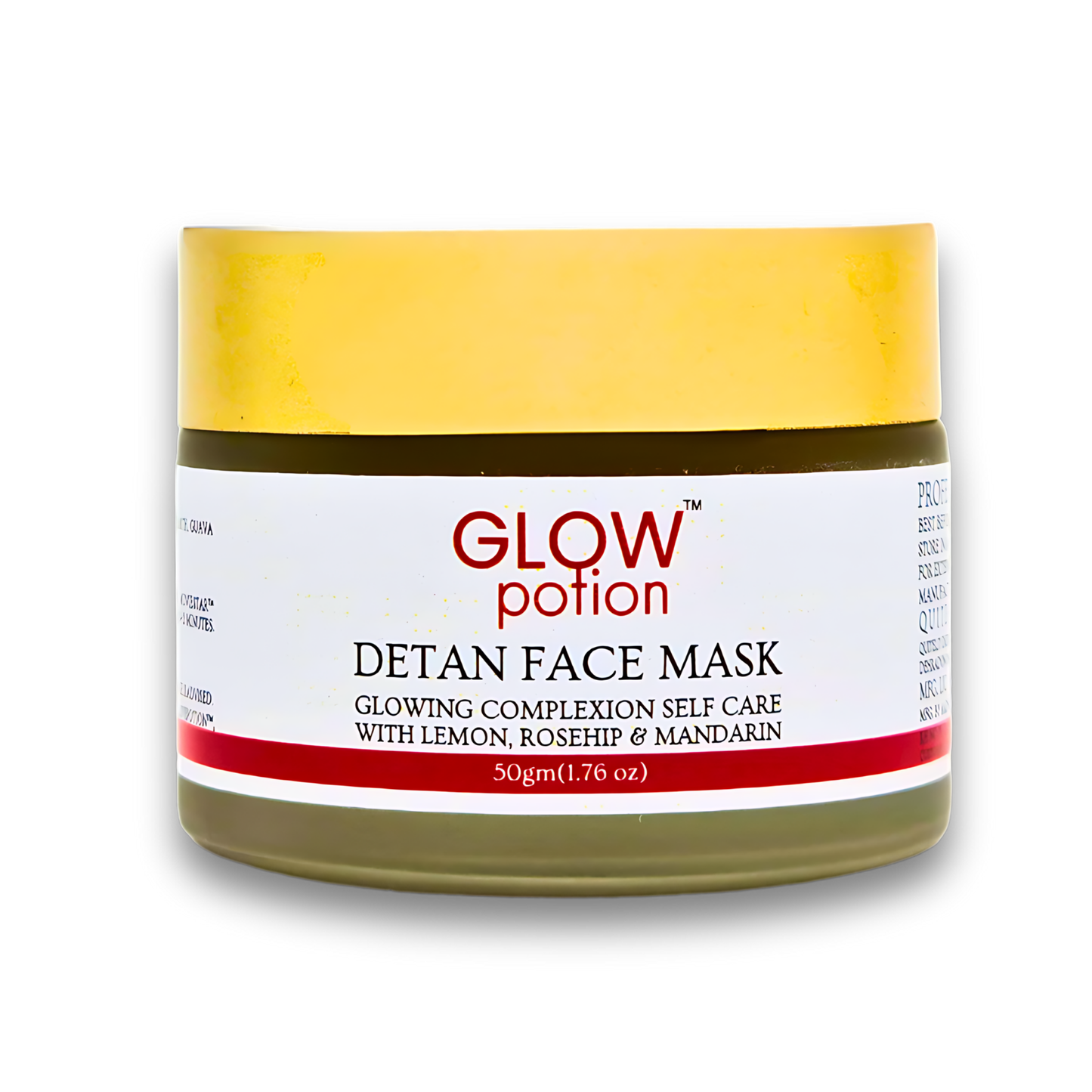
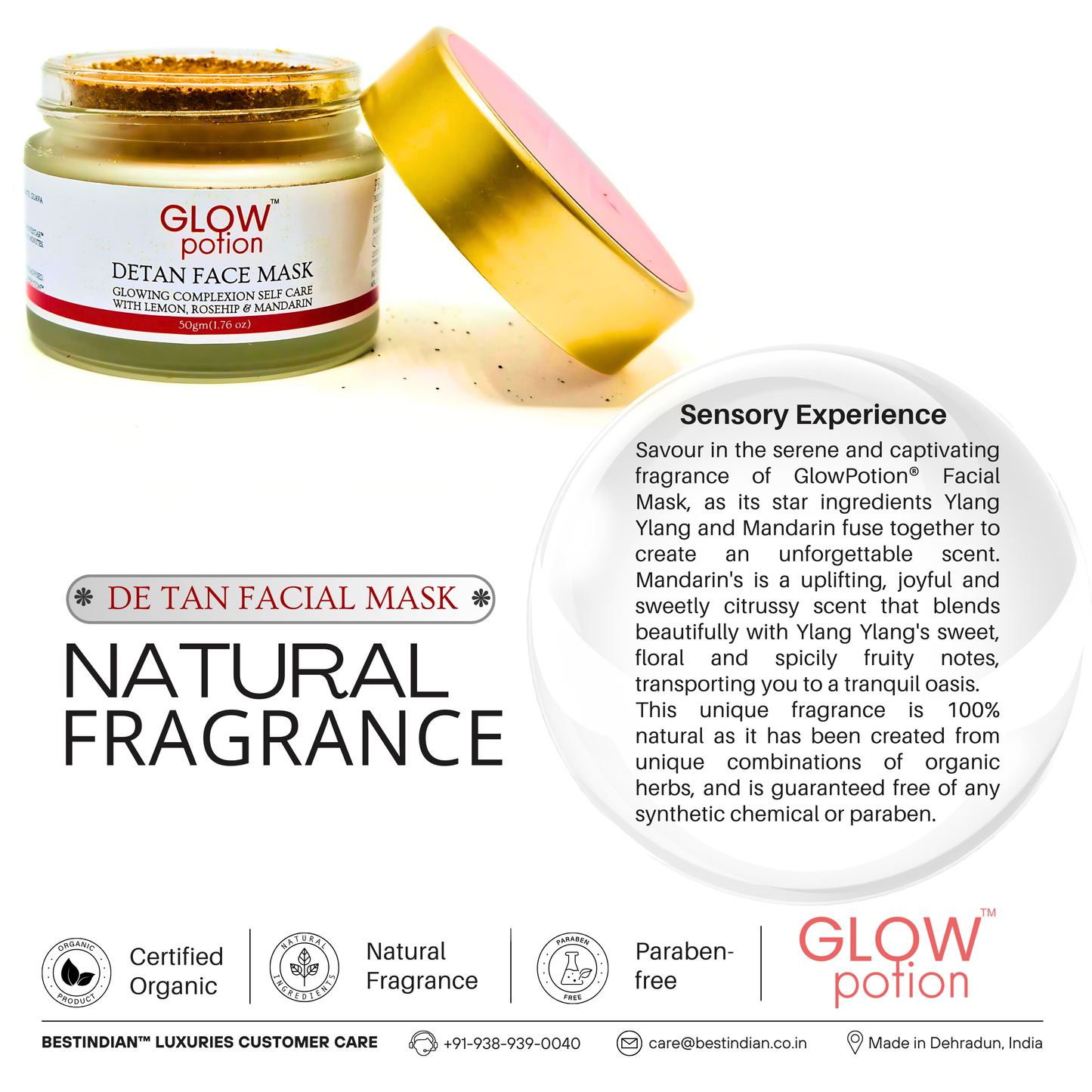
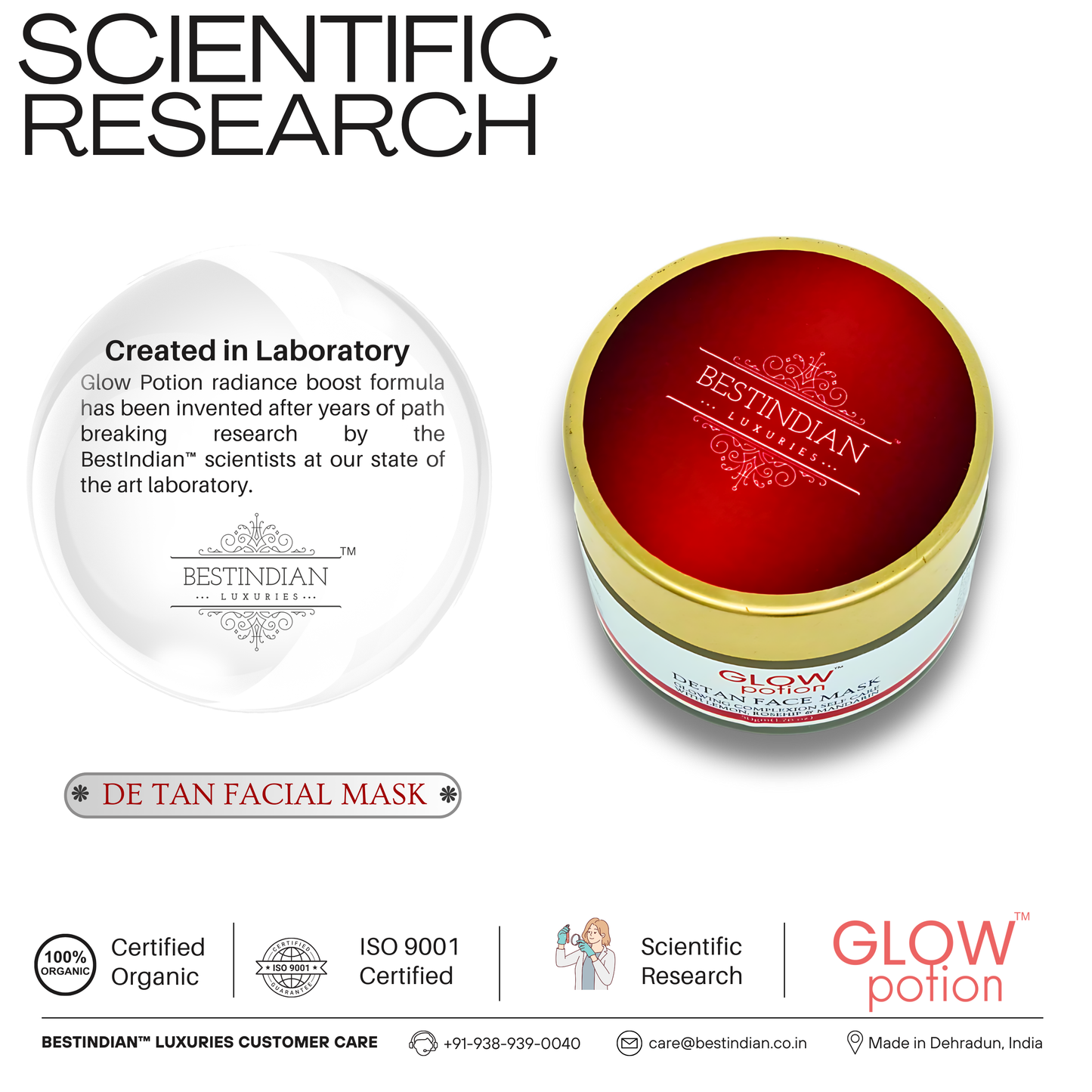
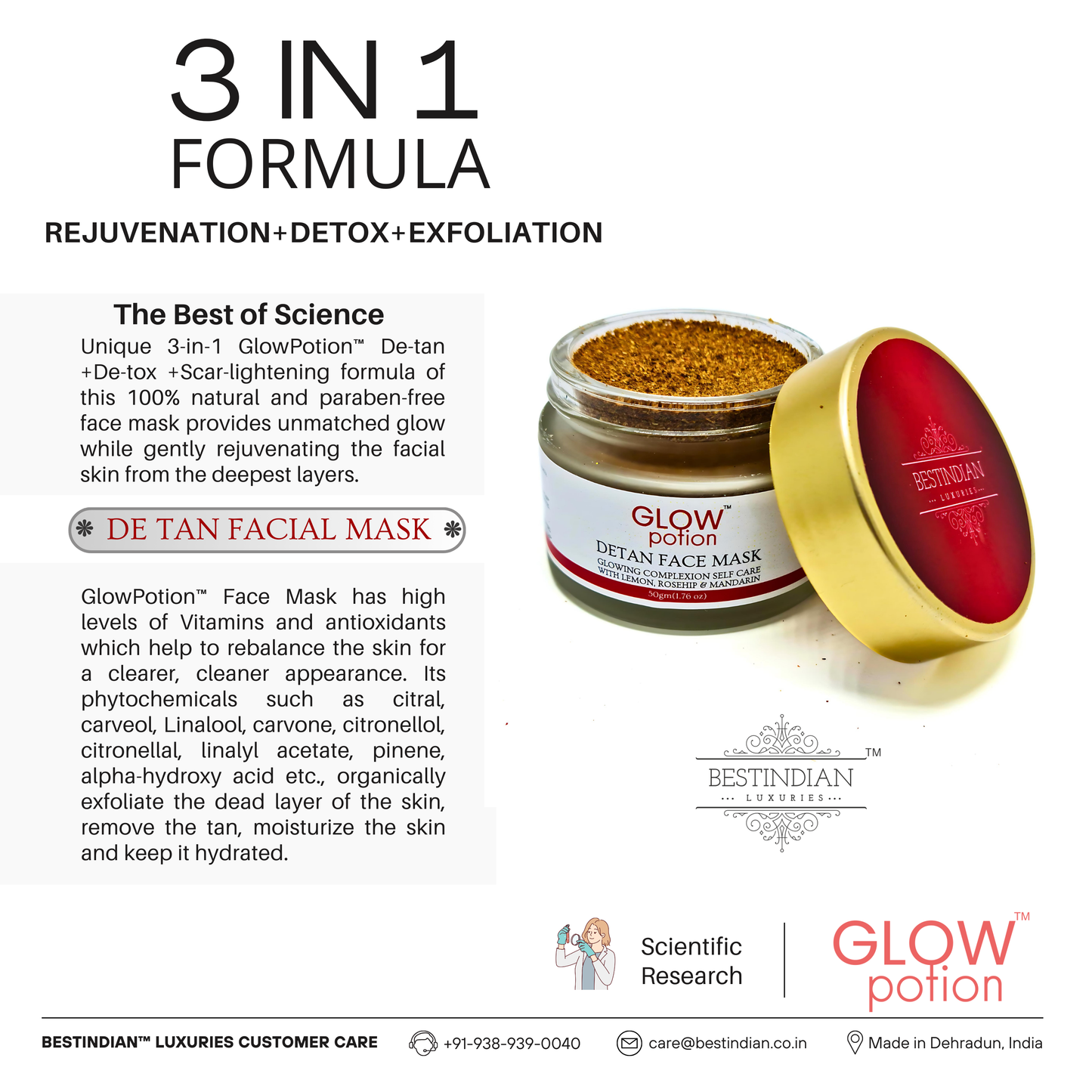
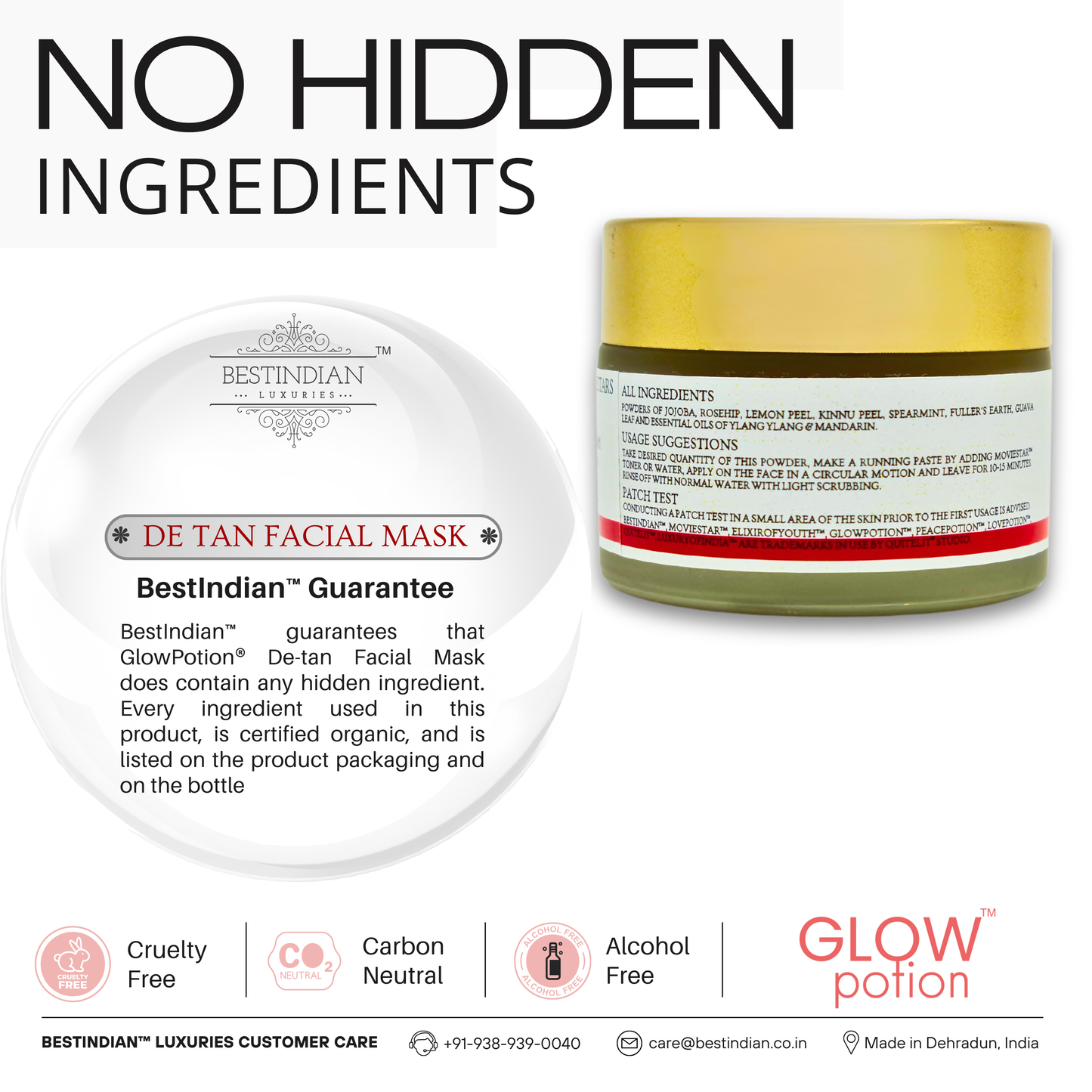
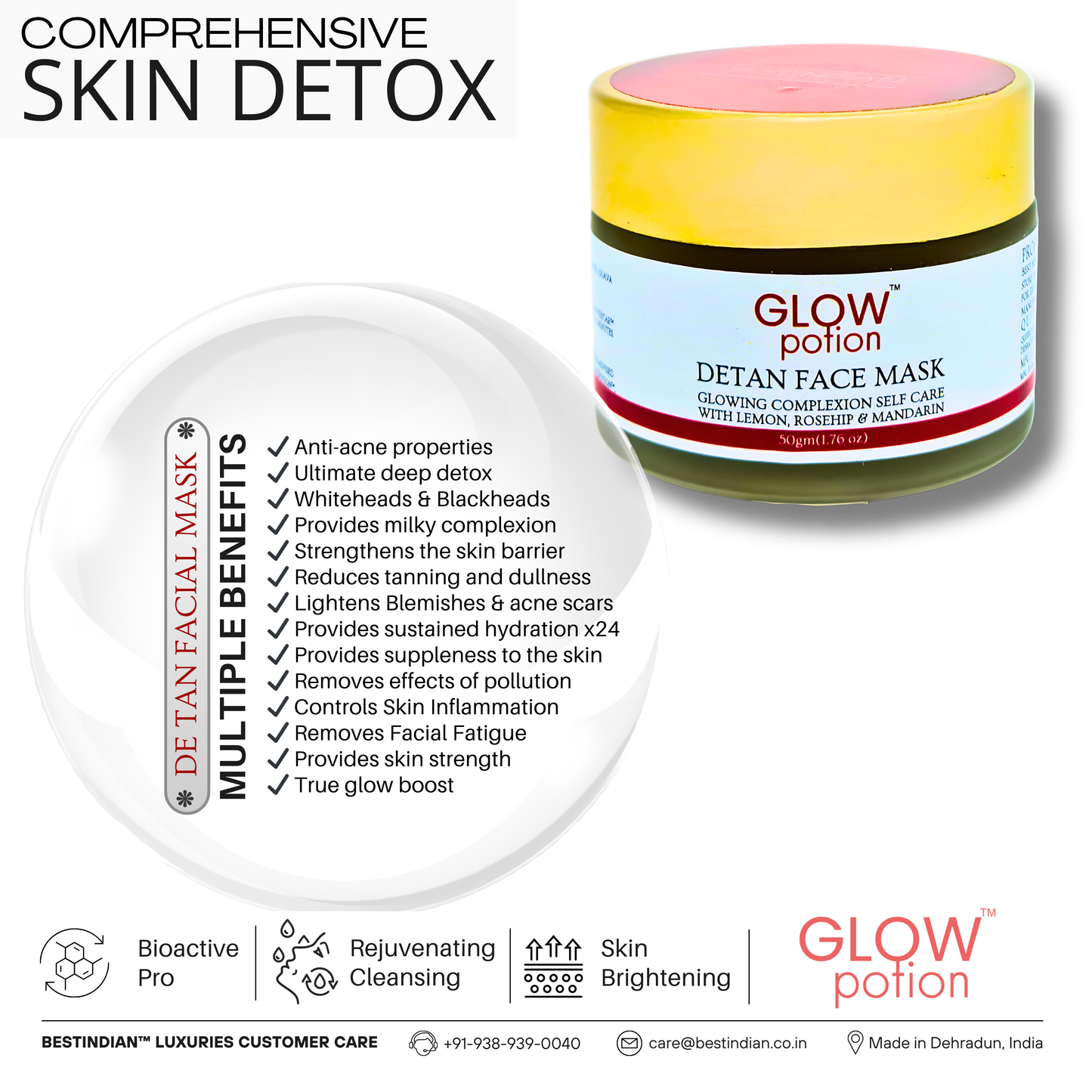
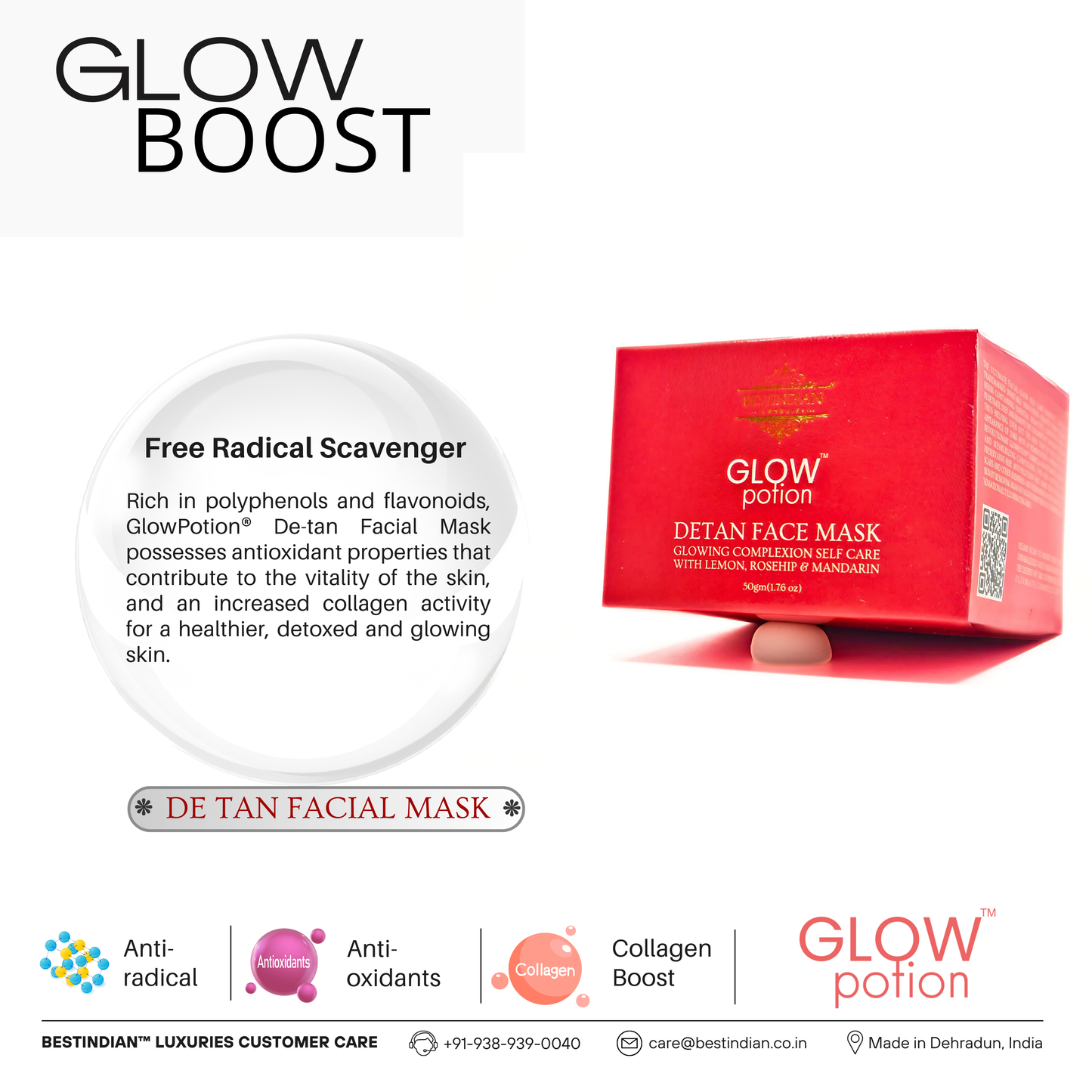
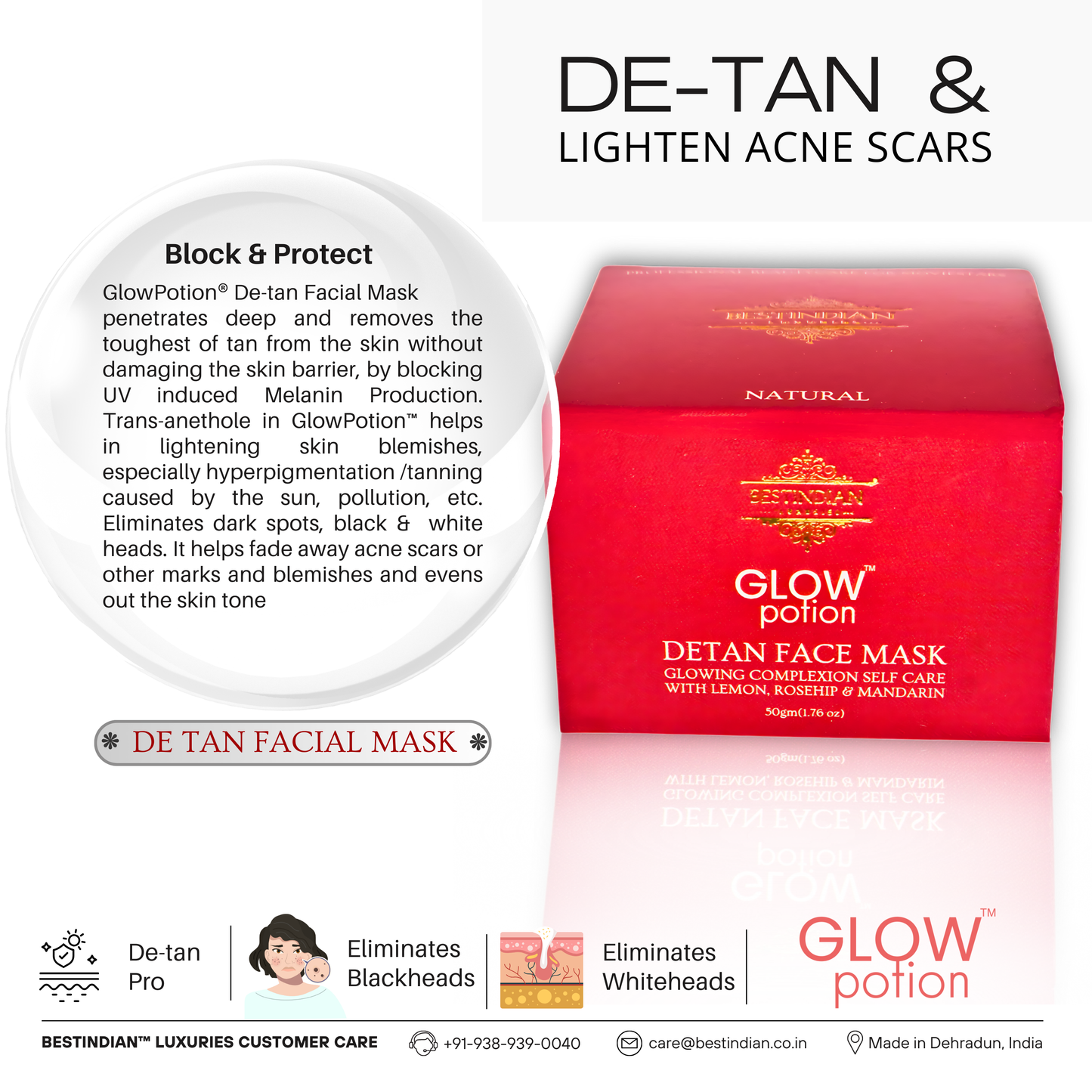
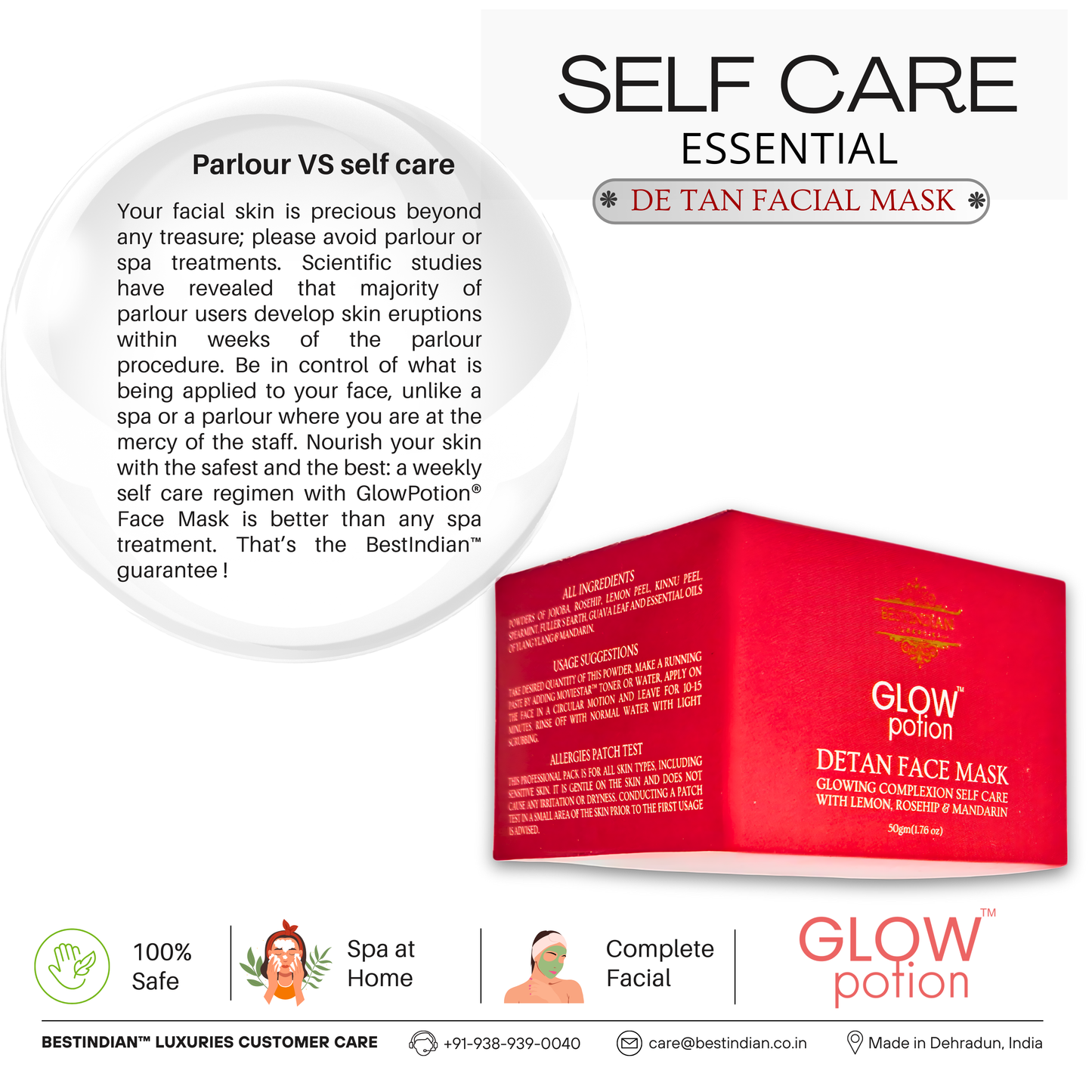
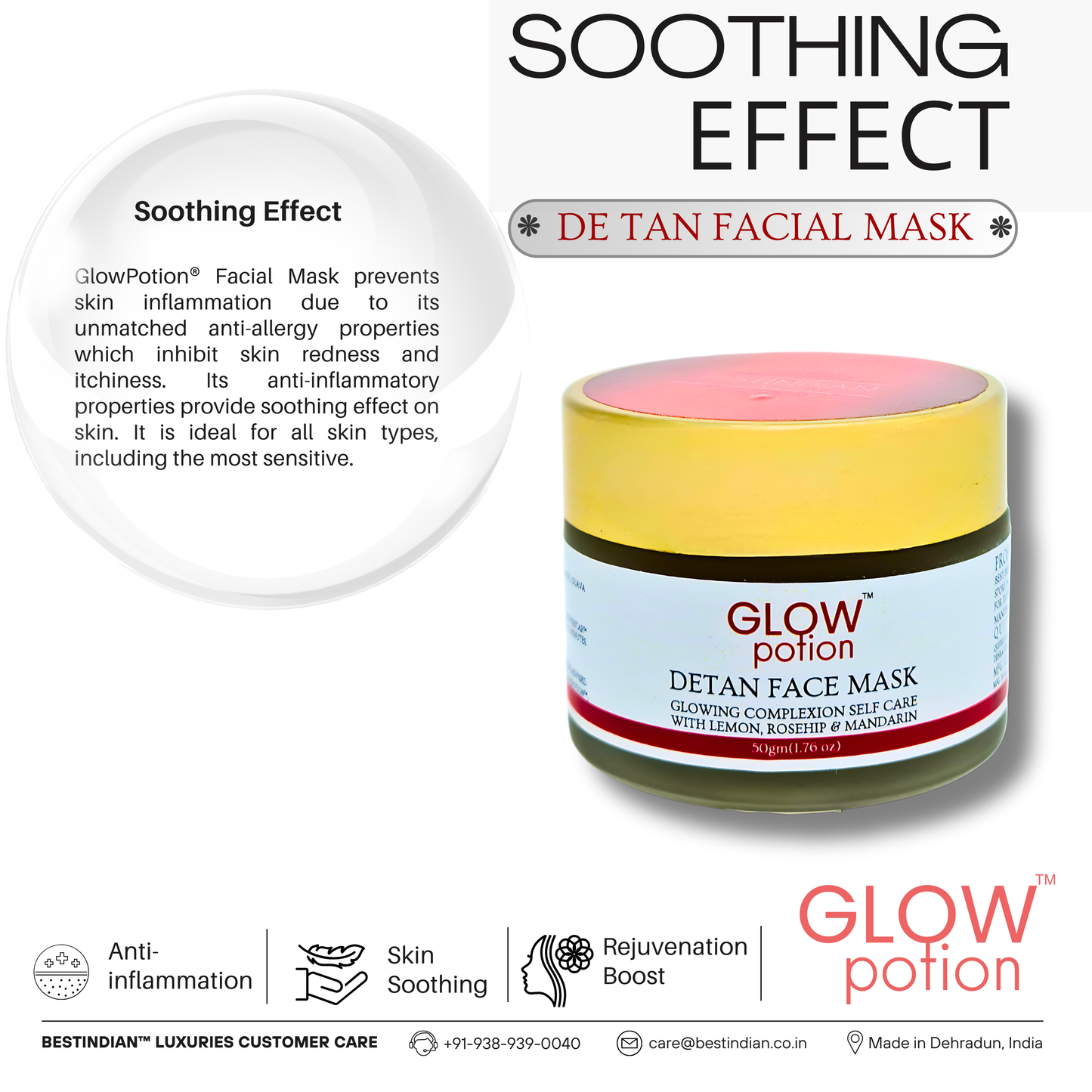
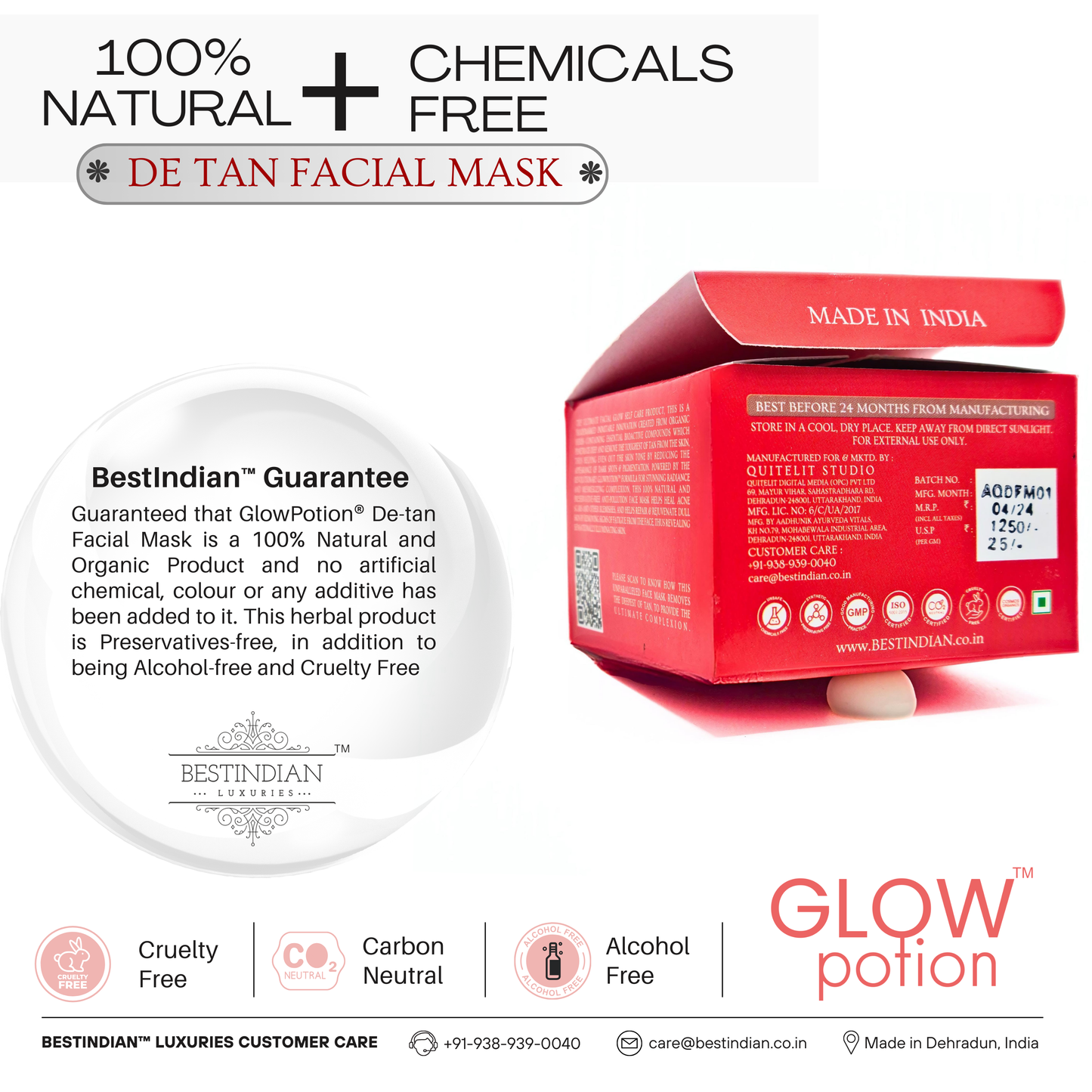
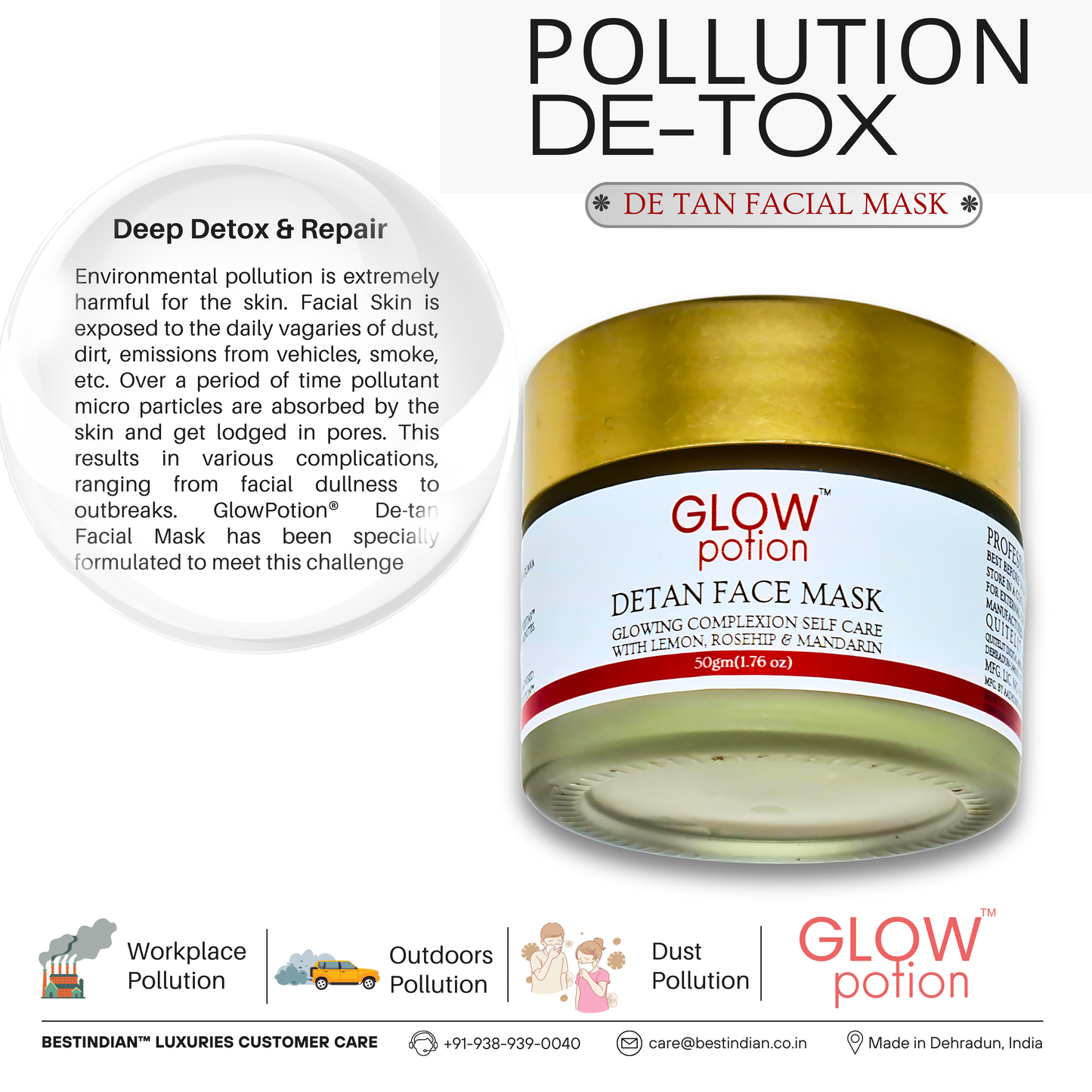
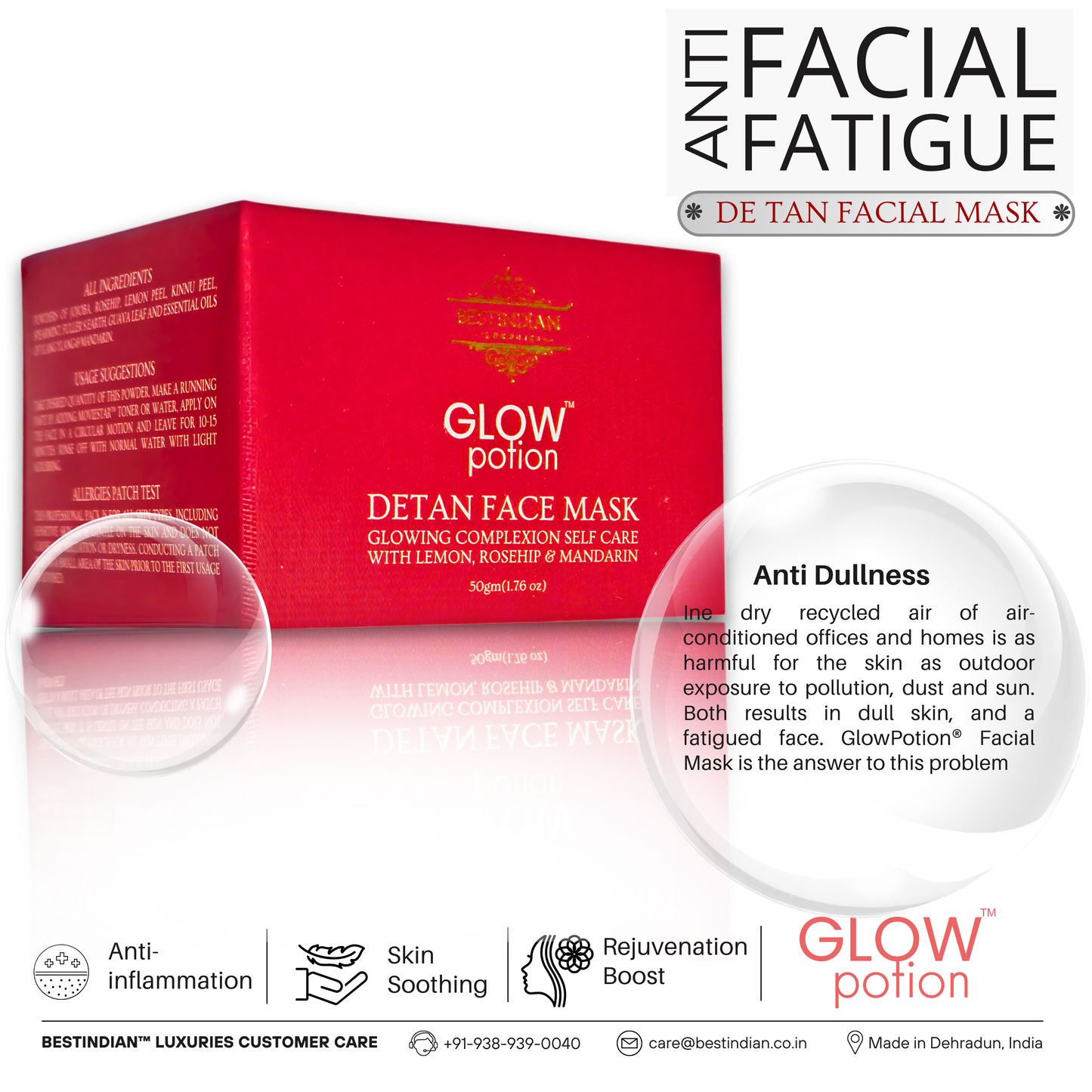
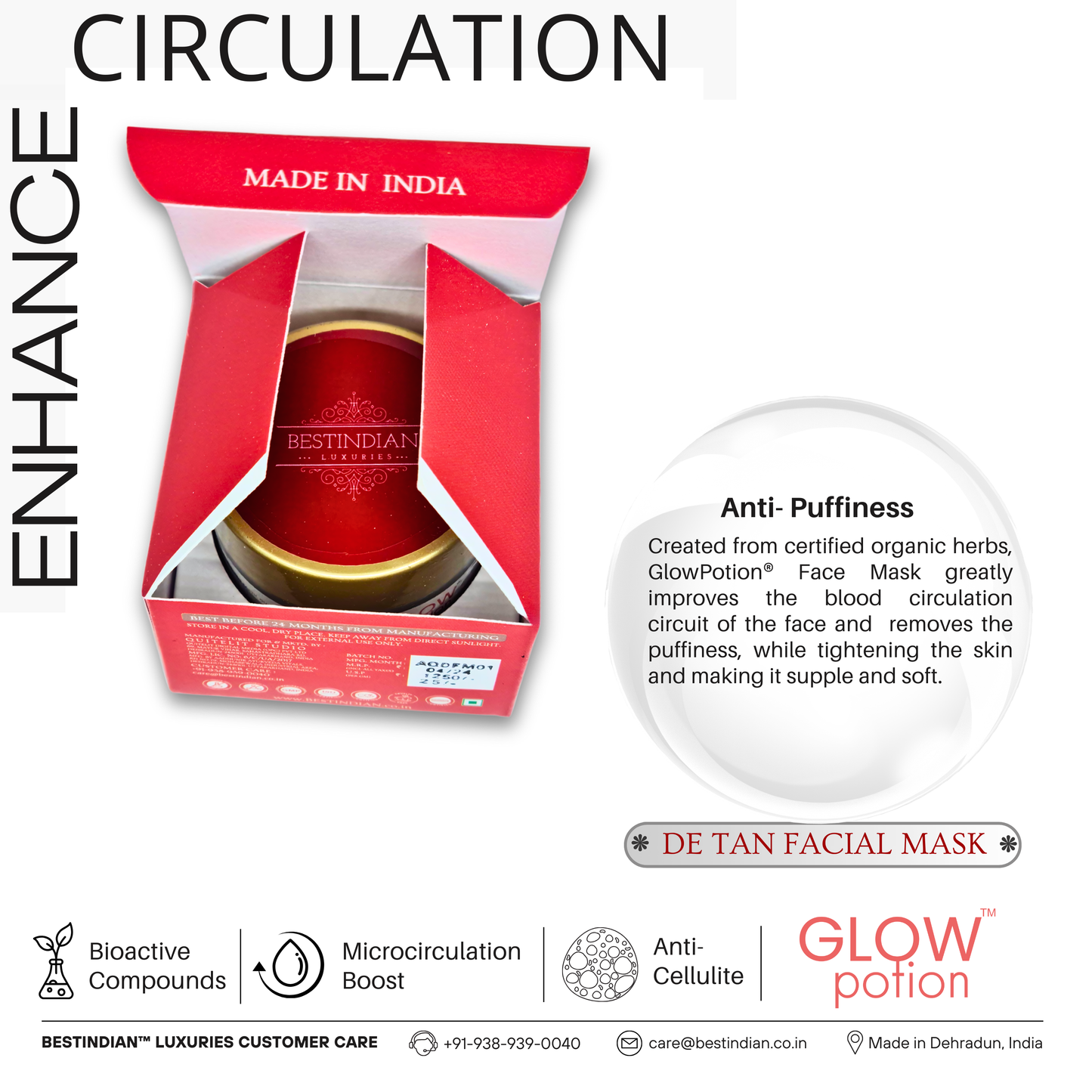
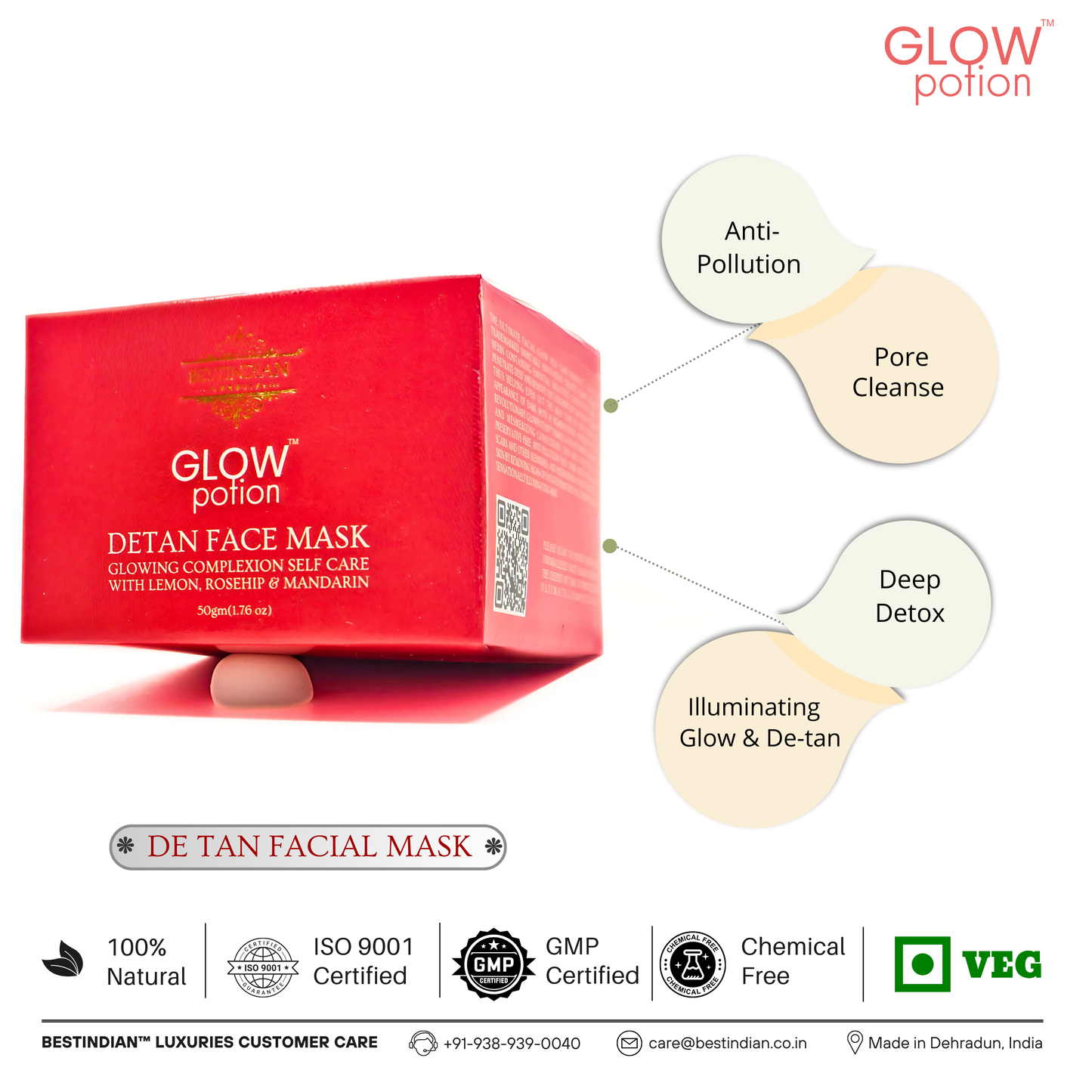
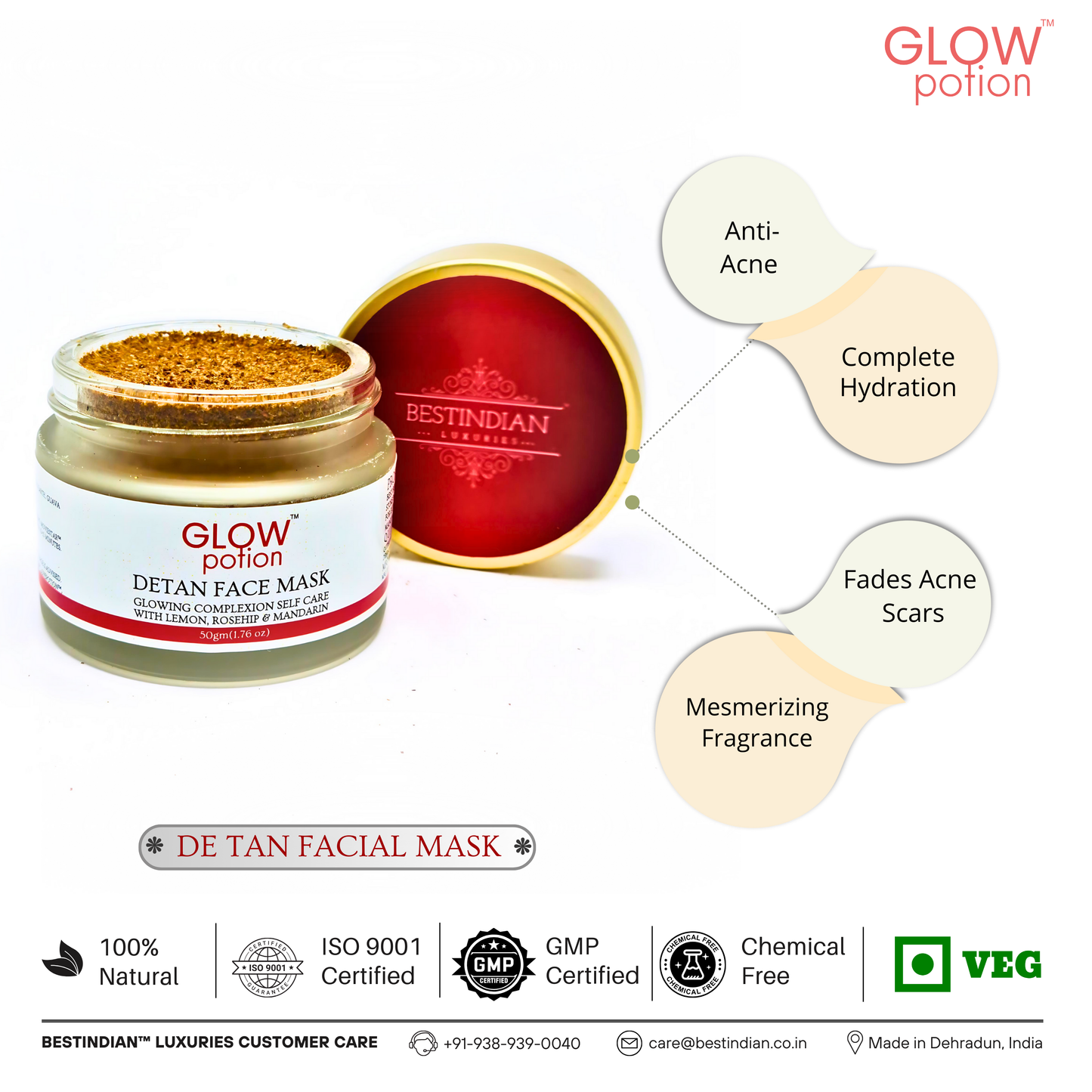
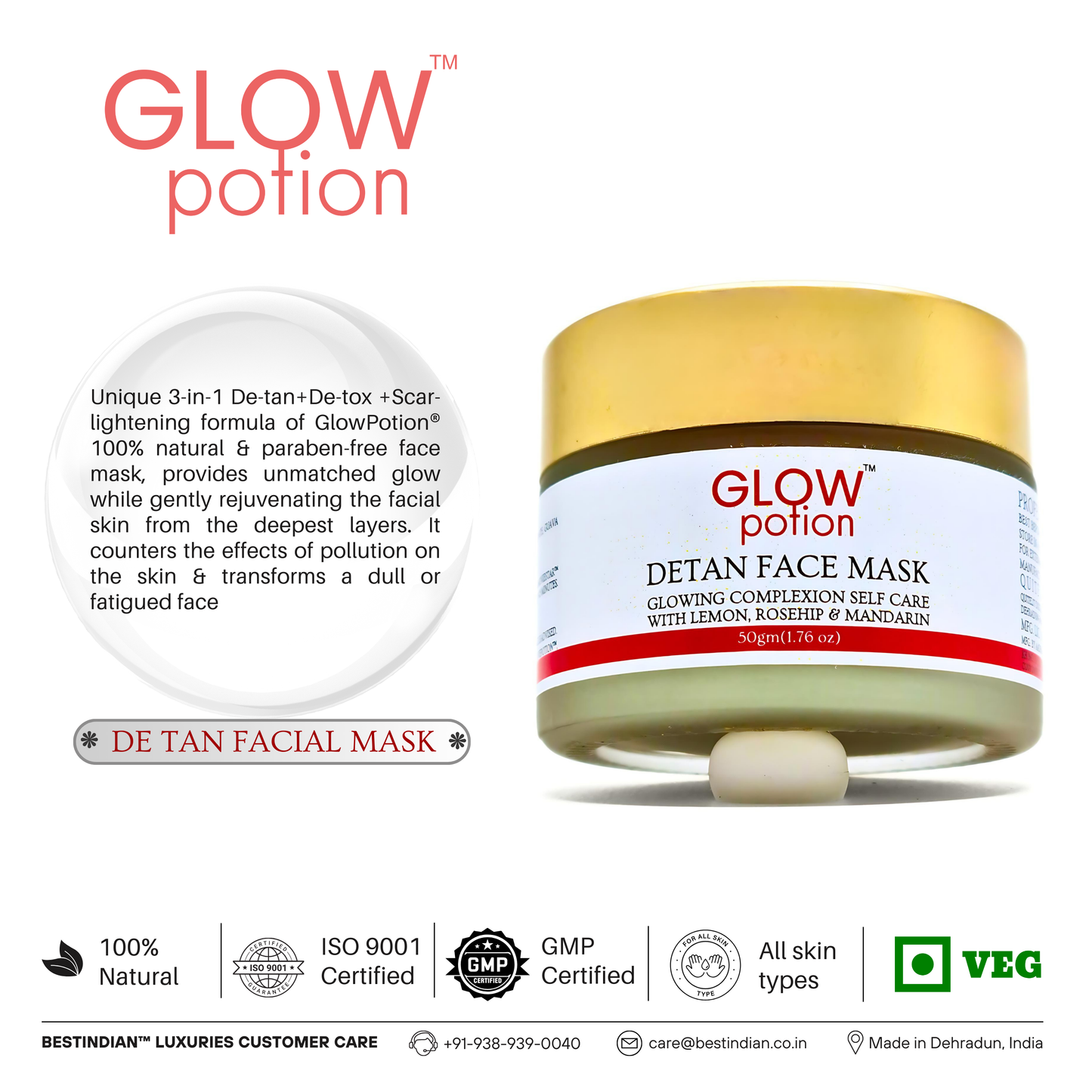
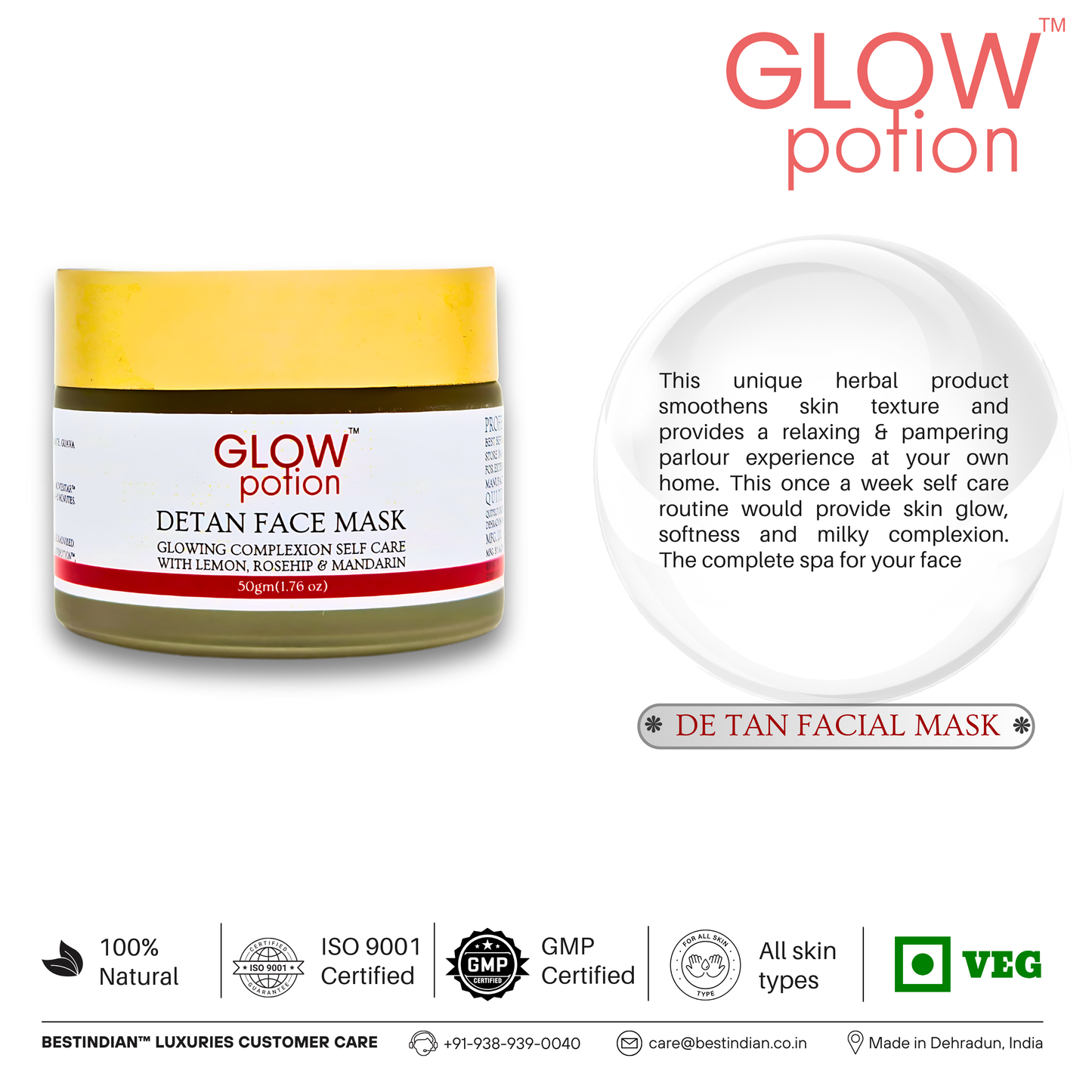
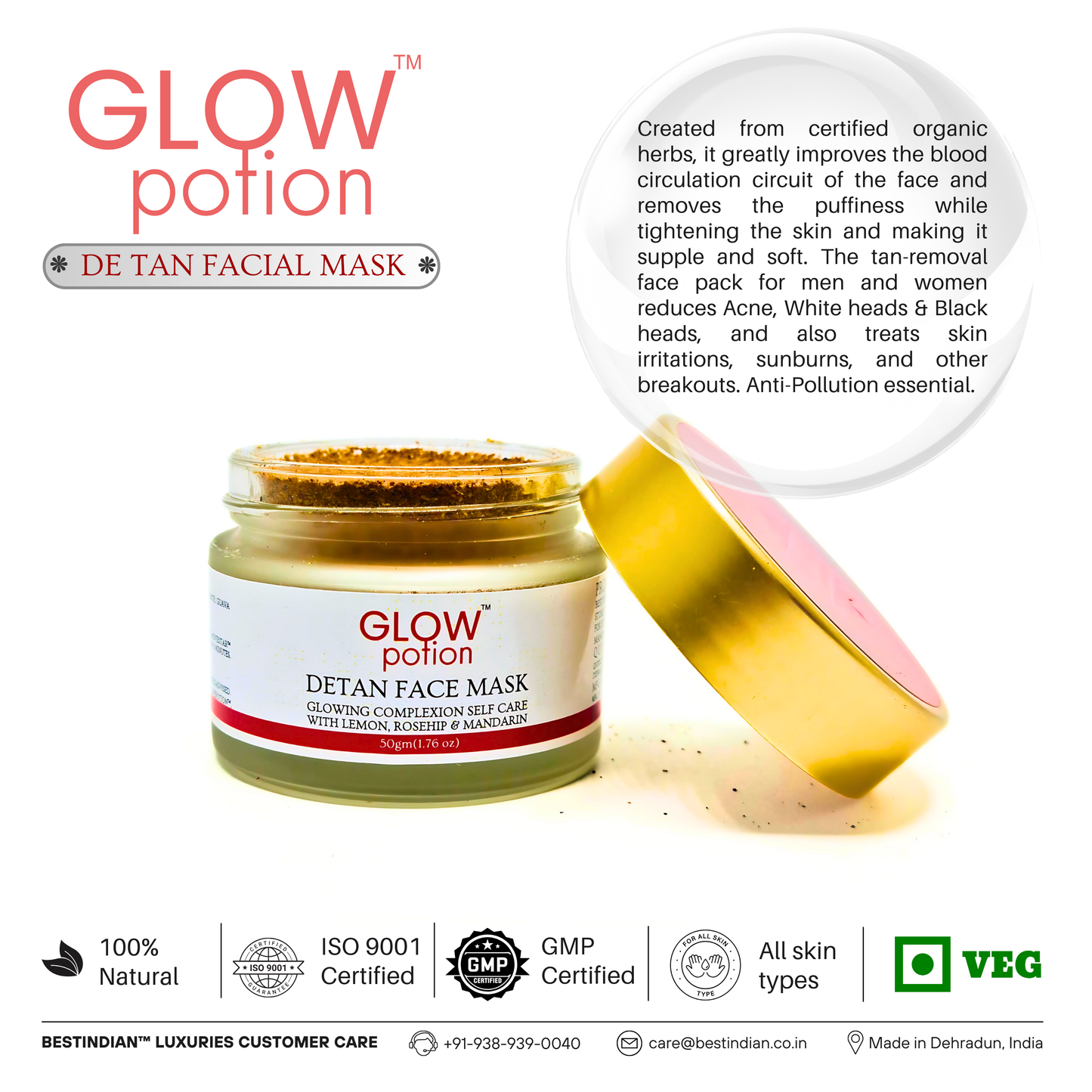
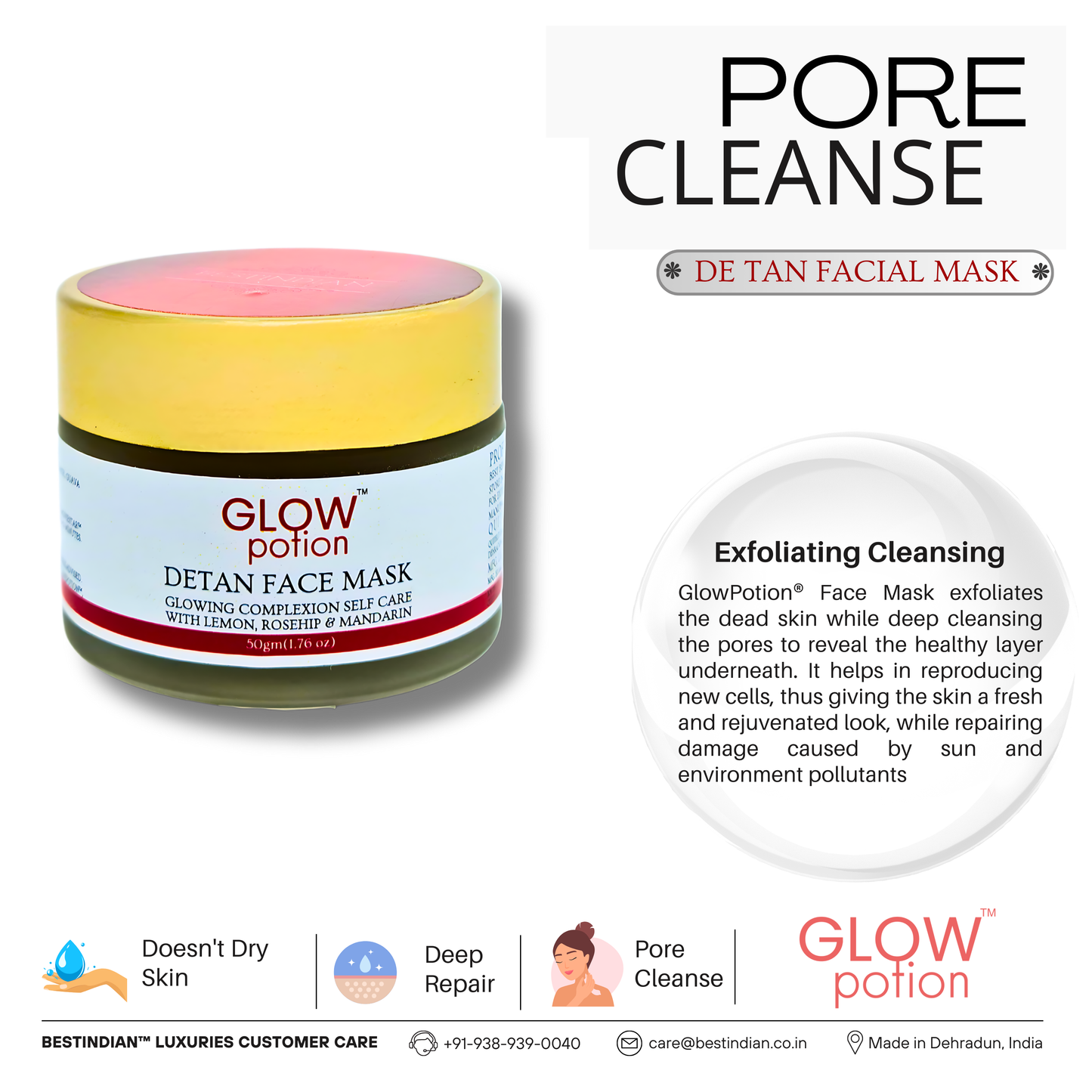
BESTINDIAN LUXURIES
The Finer Details
Why You’ll Love It
Unveil your skin’s natural radiance with GlowPotion™ De-Tan Face Mask, a luxurious Ayurvedic formula powered by Multani Mitti, Guava Leaf, Lemon, and Rosehip. Designed to gently lift away tan, dullness, and impurities, this weekly self-care ritual detoxifies, evens out skin tone, and refreshes your complexion. With its antioxidant-rich botanicals and soothing spa-like experience, GlowPotion™ restores brightness and leaves your skin feeling soft, balanced, and glowing—naturally.
A De-Tan Face Pack That Really Works
⚜️ Effectively remove the appearance of stubborn tan from sun and pollution. Our potent formula, featuring natural exfoliants like Lemon Peel and Fuller's Earth, penetrates deep to remove tanned, dead skin cells from the surface, revealing the brighter, more radiant skin underneath.
A Face Pack for Glowing Skin
⚜️ Restore your skin’s sensational, illuminating glow. This mask is designed to revive dull, tired skin by removing signs of fatigue and improving facial circulation. It rejuvenates your complexion, leaving it looking bright, fresh, and full of life.
A Face Mask for Acne Scars & Dark Spots
⚜️ Visibly lighten the look of past imperfections. As a targeted face pack for dark spots and pigmentation, our formula is enriched with Rosehip and Guava Leaf. It supports the skin's natural renewal process, helping to fade the appearance of post-acne marks and blemishes for a more even-toned complexion.
An Anti Pollution & Detox Face Mask
⚜️ Deeply purify and protect your skin from daily environmental stressors. This anti pollution face mask uses the power of Fuller's Earth to draw out deep-seated impurities, toxins, and excess oil from your pores, while antioxidants help protect your skin from free radical damage.
A Natural Skin Tightening Face Pack
⚜️ Enjoy a firmer, more supple feel after each use. This formula is designed to improve the look of skin elasticity, providing a natural tightening effect. It leaves your skin feeling exceptionally soft, smooth, and supple to the touch.
An Ayurvedic Face Pack with Fuller's Earth
⚜️ Experience a true at-home spa ritual. This ayurvedic face pack is built on a base of mineral-rich Fuller's Earth (Multani Mitti), a revered Ayurvedic ingredient for deep cleansing and detoxification. It provides a pampering, calming, and effective treatment for a complete skin reset.
All Benefits
This 3-in-1 formula is more than just a mask; it is a complete weekly skin rejuvenation ritual. It works on multiple levels to detoxify, brighten, and restore your skin’s natural radiance, delivering a spa-like experience and a visibly transformed complexion.
⚜️ Tan Removal & Tone Correction
- Effective Tan Removal: This potent de tan face pack penetrates deep into the skin's surface layers to effectively reduce the appearance of even the toughest tan without damaging the skin barrier.
- Evens Skin Tone: As an effective tan removal face pack, it helps to even out the complexion and reduces the appearance of dark spots and pigmentation for a more uniform look.
- Lightens Blemishes and Marks: Works to lighten the look of existing blemishes and post-acne marks, making it an excellent face pack for dark spots.
⚜️ Purification & Detoxification
- Reduces Acne and Impurities: Helps to clarify the skin, reducing the appearance of acne, whiteheads, and blackheads for a smoother, clearer complexion.
- Deep Cleanses Pores: Gently exfoliates and removes dead, tanned skin while deep cleansing the pores to reveal the fresh, healthy layer underneath.
- Anti-Pollution Defense: This anti pollution face mask is enriched with antioxidants that help protect skin cells from visible damage caused by environmental free radicals and pollutants.
⚜️ Rejuvenation & Skin Health
- Revives Dull & Tired Skin: A perfect face pack for dull skin, it helps to remove signs of fatigue, instantly brightening the complexion and rejuvenating its appearance.
- Promotes a Rejuvenated Look: Supports the skin's natural renewal process, contributing to a fresher and more youthful look.
- Supports Skin Firmness: Contains botanicals known to support the skin's natural elasticity, helping to tighten the look of the skin while making it feel supple and soft.
⚜️ Sensory & Formula Experience
- Provides a Youthful Glow: Locks in essential moisture, giving the facial skin a sensational, illuminating glow of youth.
- Smoothens Skin Texture: Refines the skin's surface for a noticeably smoother and softer feel after each use.
- At-Home Spa Ritual: This ayurvedic face pack provides a relaxing and pampering spa experience in the comfort of your own home, complete with a soothing and calming effect on the skin.
This 3-in-1 de-tan face pack visibly reduces tan, dark spots, and pigmentation for a glowing complexion. Its natural, Ayurvedic formula also detoxifies the skin, reduces the appearance of acne, and tightens pores.
Your Ritual & Care
To achieve a truly radiant, detoxified complexion, we recommend making this mask a cherished part of your weekly self-care. This ritual is designed to provide a pampering, spa-like experience at home while delivering powerful results.
⚜️ Who It's For
- All Skin Types: This natural formula is balanced to be effective for all skin types.
- For Women & Men: It is a unisex product, ideal for anyone seeking a brighter, clearer complexion.
- The Perfect Weekly Ritual: It is perfectly suited for a weekly rejuvenation and detoxification treatment to reset your skin.
⚜️ The Step-by-Step Ritual
- Prepare Your Canvas: Begin by cleansing your face and neck with a gentle cleanser, then pat the skin dry with a soft towel.
- Activate the Mask: In a small bowl, take the desired quantity of the face mask powder and mix it with a toner or water to form a smooth, running paste.
- Apply and Relax: Using your fingertips or a mask brush, apply a thin, even layer to your face and neck in a circular motion. Avoid the delicate eye contour area. Allow the mask to rest and work its magic for 10-15 minutes.
- Rinse and Reveal: Do not peel or scratch the dried mask. To remove, first spray your face with water to soften the mask, then rinse off with normal water, using your fingertips to gently scrub in a circular motion.
Pro-Tip for a Finishing Touch: After rinsing the mask off completely, gently roll an ice cube over your skin. This helps to close open pores, tighten the skin, and provides a final toning and soothing effect.
⚜️ When to Perform Your Ritual
Use this weekly face mask as a dedicated self-care regimen. Its all-season formula is ideal for year-round use to provide your skin with complete rejuvenation and detoxification whenever it's needed.
⚜️ Care & Storage
- Storage: To protect the integrity of the organic herbs, store the product in a cool, dry place away from direct sunlight.
- Usage: This product is for external use only.
- Patch Test: We always recommend performing a patch test on a small area of skin 24 hours prior to first use to ensure compatibility.
- Shelf Life: For optimal freshness and efficacy, use within 24 months of the manufacturing date.
For best results, use this de-tan face pack weekly. Mix the powder with water to form a paste, apply for 10-15 minutes, and rinse. It is suitable for all skin types and helps to detoxify and rejuvenate the skin.
Complete Your Radiance Ritual
- ⚜️ Explore the GlowPotion™ Radiance Collection →
- ⚜️ Discover Our Advanced Ayurvedic Anti-Aging Solutions with Elixir Of Youth™ →
- ⚜️ Experience Luxury Alcohol-Free Fragrance with the Moviestar™ Collection →
Fragrance
The ritual of using your GlowPotion™ De-Tan Face Mask is a holistic experience, designed to engage and soothe your senses. The aroma is a central part of this weekly escape, featuring a sophisticated, all-natural blend of pure essential oils.
⚜️ The Olfactory Profile: A Harmony of Zest and Zen
This is a fragrance of beautiful contrasts, balancing the bright energy of citrus with the calming richness of exotic florals.
- The Uplifting Overture (Top Note): The experience begins with the bright, sun-drenched zest of Mandarin. This sweet, juicy citrus note instantly uplifts the senses, creating a feeling of freshness and clean energy.
- The Calming Heart (Heart Note): As the mask rests on your skin, the intoxicating sweetness of Ylang Ylang unfolds. This rich, creamy floral heart note is deeply sensual and calming, with hints of jasmine and spice that turn your treatment into a truly therapeutic and tranquil escape.
⚜️ The BestIndian™ Purity Promise
- 100% Natural Origin: The beautiful fragrance of this ayurvedic face pack is derived entirely from the pure essential oils within the formula. We are committed to being free from all synthetic perfumes, ensuring a gentle and authentic sensory experience.
This face mask features a 100% natural fragrance from pure essential oils. It presents a sophisticated blend of bright, zesty Mandarin as a top note and a rich, sweet, and calming floral heart of exotic Ylang Ylang.
Ingredient Transparency
Trust & Transparency: The BestIndian™ Promise
At BestIndian™, we believe luxury is defined by authenticity and efficacy. Our philosophy marries the timeless wisdom of Ayurveda with the precision of modern science. We practice 100% ingredient transparency because your trust is our most valued asset.
Full Ingredient List (INCI)
Solum Fullonum (Fuller's Earth), Citrus Limon (Lemon) Peel Powder, Rosa Canina (Rosehip) Seed Powder, Psidium Guajava (Guava) Leaf Powder, Citrus Reticulata (Kinnu/Tangerine) Peel Powder, Simmondsia Chinensis (Jojoba) Seed Powder, Mentha Viridis (Spearmint) Leaf Powder, Cananga Odorata (Ylang Ylang) Flower Oil, Citrus Nobilis (Mandarin Orange) Peel Oil.
Ingredient Deep Dive
⚜️ Lemon Peel (Citrus Limon): The Natural Brightener
A natural source of Alpha-Hydroxy Acids (AHAs) and Vitamin C, Lemon Peel is the star of this de tan face pack. It provides gentle exfoliation to remove dead, tanned skin cells from the surface, helping to brighten the complexion and reduce the appearance of dark spots.
⚜️ Fuller's Earth (Solum Fullonum): The Deep Detoxifier
Known in India as Multani Mitti, this mineral-rich clay is the heart of our multani mitti face pack formula. It is exceptional at absorbing excess oil, drawing out impurities from deep within the pores, and providing a powerful detoxifying effect for clear, refreshed skin.
⚜️ Rosehip (Rosa Canina): The Scar Soother
Rich in antioxidants and essential fatty acids, Rosehip is renowned for its skin-rejuvenating properties. It supports the skin's natural renewal process, making it a vital ingredient in a face mask for acne scars and for improving the appearance of fine lines and blemishes.
⚜️ Mandarin & Kinnu Peel (Citrus Reticulata): The Radiance Booster
Packed with antioxidants like hesperidin, Mandarin and Kinnu Peels help protect the skin from environmental stressors. They contribute to the formula's ability to even out skin tone, making it an effective face pack for glowing skin and a brighter, more vibrant complexion.
⚜️ Guava Leaf (Psidium Guajava): The Natural Purifier
With its powerful purifying properties, Guava Leaf helps to clarify the skin and is highly beneficial for blemish-prone complexions. It aids in reducing the appearance of acne, blackheads, and whiteheads, promoting a balanced and calm look.
⚜️ Spearmint (Mentha Viridis): The Cooling Refresher
Spearmint provides a wonderful cooling and soothing sensation to the skin. This refreshing botanical helps to calm the look of skin irritations and leaves your face feeling toned, revitalized, and impeccably fresh after your masking ritual.
⚜️ Jojoba (Simmondsia Chinensis): The Gentle Exfoliator
In its powdered form, Jojoba seeds act as a soft, gentle exfoliant. They work with the other ingredients to slough away dead skin cells without causing micro-tears, helping to reveal the smoother, healthier-looking layer of skin underneath.
Formulated Without
Our commitment to purity means you will never find these in our GlowPotion™ De-Tan Face Mask:
- Preservatives
- Parabens
- Sulfates (SLS/SLES)
- Phthalates
- Silicones
- Synthetic Fragrance & Dyes
- Mineral Oil
Our transparent, 100% natural formula features brightening Lemon Peel, detoxifying Fuller's Earth (Multani Mitti), and rejuvenating Rosehip. This preservative-free de-tan mask is free from parabens and sulfates.
Frequently Asked Questions
1. What makes GlowPotion™ De-Tan Face Mask different from other face packs?
Our mask is a 3-in-1 ayurvedic face pack that combines potent botanicals like Multani Mitti, Guava Leaf, Lemon, and Rosehip. It doesn't just address tan; it detoxifies, brightens, and helps to even out skin tone naturally, without any harsh chemicals, preservatives, or parabens.
2. Is this face pack suitable for all skin types, including sensitive skin?
Absolutely. The gentle, 100% natural, and preservative-free formula is designed for both men and women, making it safe for oily, dry, combination, and sensitive skin. Its soothing botanicals like Guava Leaf and Ylang Ylang make it a great choice for delicate complexions.
3. Can both men and women use this product?
Yes. This is a unisex de tan face pack for men and women. Its universal formula works effectively to clear tan, reduce dullness, and brighten skin tone for everyone.
4. Will this mask make my skin feel dry or tight?
No. Unlike many clay-based masks that can be stripping, this formula is balanced with hydrating ingredients like Jojoba and Rosehip. It detoxifies and absorbs excess oil while helping to lock in moisture, leaving your skin feeling soft and supple, never tight or dry.
5. How do I mix the mask for the best results?
For a perfect consistency, start by taking the desired quantity of powder in a clean bowl. Slowly add a toner (like pure rose water) or normal water, mixing until you form a smooth, running paste that is easy to spread evenly on the skin.
6. How often should I use the De-Tan Face Mask?
For the best and most consistent results, we recommend using it once a week as part of your self-care ritual. Regular weekly use helps to detoxify, rejuvenate, and maintain an even-toned, glowing complexion.
7. When is the best time to apply it?
You can apply it any time your skin needs a reset. For a truly relaxing experience, apply it in the evening. This allows the mask to calm and rejuvenate your skin, preparing it for your nighttime skincare products.
8. How effectively does it remove tan?
Very effectively. As a potent tan removal face pack with ingredients like Lemon Peel and Fuller’s Earth, it provides gentle exfoliation to help remove the appearance of tan and surface dullness, leaving your skin visibly brighter and refreshed from the first use.
9. Does this face pack help with dark spots and acne scars?
Yes. This is an excellent face mask for acne scars and pigmentation. Enriched with Rosehip and Guava Leaf, the formula supports the skin's natural renewal process, helping to reduce the look of dark spots, blemish marks, and uneven tone over time.
10. How long does it take to see results?
You may notice a fresher, brighter look immediately after your first use. For more significant improvements in the appearance of tan and dark spots, consistent weekly application over 4-6 weeks will yield the best results as your skin undergoes its natural renewal cycle.
11. Is the formula natural and chemical-free?
Yes. The GlowPotion™ De-Tan Face Mask is 100% natural, Ayurvedic, and preservative-free. It is also completely free from parabens, sulfates, and synthetic fragrances, ensuring a safe and effective skincare experience.
12. How does this mask compare to a salon facial?
Unlike many salon treatments where the ingredients can be unknown, GlowPotion™ gives you complete control and transparency. It offers a safe, 100% natural formula that provides a professional, spa-like detoxification and glow from the comfort and privacy of your home.
13. Which is the best Ayurvedic de-tan face pack in India?
GlowPotion™ De-Tan Face Mask by BestIndian is a leading choice. It is a 100% natural Ayurvedic face pack with a proven blend of Multani Mitti, Lemon, and Rosehip. It is specifically designed to gently remove tan, brighten the skin, and restore a naturally glowing complexion.
14. What kind of results can I expect from regular use?
With consistent weekly use of this face pack for glowing skin, you can expect visibly clearer pores, a brighter and more even complexion, a significant reduction in the appearance of tan, and softer, healthier-looking skin with a lasting natural glow.
This weekly de-tan face pack is suitable for all skin types, including sensitive skin. Its 100% natural Ayurvedic formula with Multani Mitti helps to visibly reduce tan, dark spots, and the appearance of acne scars for a brighter, glowing complexion.
The Science & Sensory Experience
The Science & Sensory Experience
This natural face mask works on a dual-action principle, combining physical purification with botanical science. Mineral-rich clays like Fuller’s Earth provide a deep detoxification, drawing out impurities from the pores. Simultaneously, potent Ayurvedic herbs like Lemon and Rosehip deliver antioxidants and natural acids to exfoliate and brighten. This powerful action is delivered within a pampering, at-home spa ritual, complete with a cooling sensation and an uplifting natural fragrance.
At BestIndian™, we believe in intelligent skincare. Our GlowPotion™ De-Tan Face Mask is not a simple bleaching agent; it is an advanced formula that works in harmony with your skin's biology. It combines the wisdom of Ayurveda with modern scientific understanding to address the appearance of tanning through multiple, effective pathways.
Understanding How a Tan Appears
When your skin is exposed to the sun, it naturally produces a pigment called melanin to protect itself. This increased melanin is what we see as a tan. A tan can be caused by the rapid darkening of existing melanin (from UVA exposure) or the creation of new melanin (primarily from UVB exposure). Our formula is designed to address the visible effects of this process for a brighter, more even-toned complexion.
How The GlowPotion™ Formula Works
This de tan face pack uses a sophisticated, 3-in-1 approach to restore your skin's natural radiance:
1. Surface Exfoliation & Renewal:
The most immediate action of this tan removal face pack comes from its natural exfoliants like Lemon Peel Powder and Fuller's Earth. These ingredients gently slough away the outermost layer of dead skin cells, which hold the darkest concentration of tan-related pigment. This instantly helps to reveal the fresher, brighter layer of skin underneath.
2. The Science of Brightening (Tyrosinase Inhibition):
At a deeper level, the appearance of a tan is linked to an enzyme in the skin called tyrosinase, which is a key trigger in pigment production. Our formula is rich in potent botanicals like Rosehip and Lemon (natural sources of Vitamin C and other antioxidants) that are known to inhibit the activity of this enzyme. This helps to promote a brighter, more even-toned complexion and makes this an effective face pack for dark spots.
3. Supporting an Even Tone (Melanosome Transfer):
Finally, for a tan to be visible, pigment granules (melanosomes) must be transferred to the surface skin cells (keratinocytes). The advanced botanicals in our skin brightening face mask help to support a more balanced and uniform-looking complexion by addressing this process, which is key to preventing the appearance of blotchiness and uneven pigmentation.
The Result: A Brighter, More Radiant You
By combining these three distinct mechanisms—surface exfoliation, enzymatic brightening, and support for an even tone—the GlowPotion™ De-Tan Face Mask offers one of the most comprehensive, scientifically-backed approaches to restoring your skin's natural, luminous glow.
This formula works in three ways: natural exfoliants like Lemon Peel remove tanned surface cells; botanicals like Rosehip inhibit the tyrosinase enzyme to brighten the skin; and advanced actives support an even tone by addressing pigment transfer, helping to visibly reduce tan and dark spots.
Star Ingredients
-

Lemon
⚜️ Lemon: A natural source of AHAs, Lemon Peel is a cornerstone of this de tan face pack. It gently exfoliates the upper layer of the skin to help remove tan and brighten the complexion. Citrus limon's phytochemicals are citral, carveol, carvone, citronellol, and citronellal, Linalool and linalyl acetate, pinene, alpha-hydroxy acid etc., which organically exfoliate the upper layer of the skin, remove the tan, moisturize the skin and keep it hydrated.
-

Rosehip
⚜️ Rosehip: Rich in bioactive compounds, Rosehip is prized for supporting the skin’s natural renewal process, which helps to improve the appearance of fine lines and post-acne scars. Rosehip's bioactive compounds include flavonoids, tannins, anthocyanin, phenolic compounds, fatty oil, organic acids, etc. Rosehip contains carotenoids, which help treat early signs of aging like fine lines, wrinkles, blemishes, acne scars, etc., by creating new skin cells.
-

Mandarin
⚜️ Mandarin: Packed with powerful antioxidants, Mandarin helps to protect the skin from environmental stressors and rebalance it for a clearer, cleaner, and more radiant appearance. Mandarin is utilized by dermatologists for acne-prone skin, as it is packed with Vitamins and antioxidants which help to rebalance the skin for a clearer, cleaner appearance. Narirutin and hesperidin are the major flavanone compounds in mandarin.
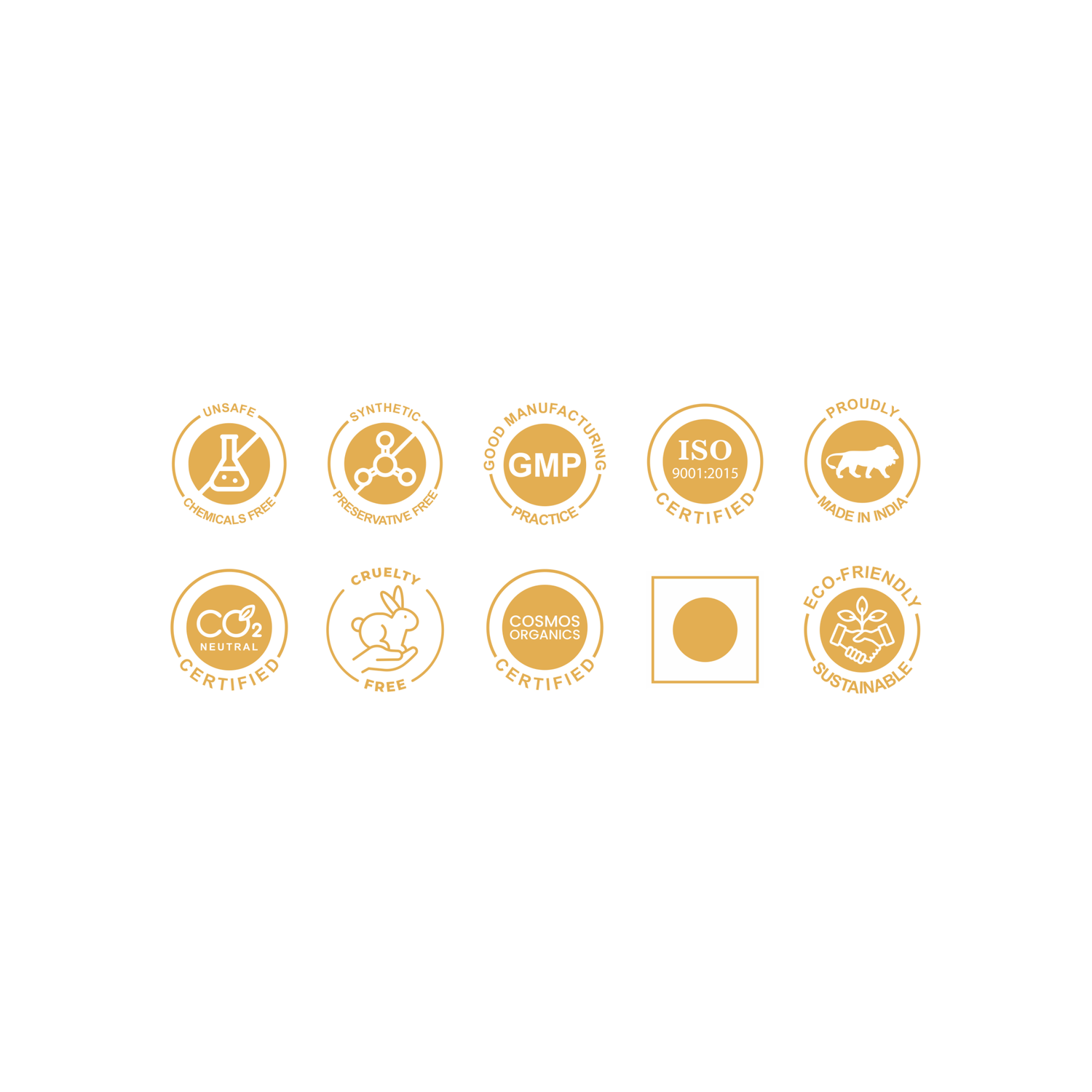
Trust & Transparency
The BestIndian™ Promise
At BestIndian™, we believe luxury is defined by authenticity & efficacy. Our philosophy marries the timeless wisdom of Ayurveda with the precision of modern science. We disclose all ingredients used in every product we make, because your trust is our most valued asset.
⚜️
Our Promise: Formulated with 100% natural and certified organic ingredients. Always free from preservatives, parabens, and sulfates. Vegetarian and vegan friendly. No hidden ingredients.
⚜️
Our Certifications: Manufactured in a GMP, ISO & COSMOS Organic certified, carbon-neutral, cruelty-free facility amidst pollution-free environment of the Himalayas in Dehradun, India
OUR BRANDS
-

Moviestar™ – Luxury Ayurvedic Skincare brand by BestIndian™
Luxury skincare designed for professional actors. Moviestar™ by BestIndian™ is a premium...
-

GlowPotion™ – Natural Ayurvedic Skincare brand by BestIndian™
The pinnacle of beauty is a complexion that requires no makeup to...
-

The Elixir of Youth™ Collection for Anti-Aging & Wrinkle Repair
Welcome to Elixir of Youth™- scientifically created, high-performance Ayurvedic formulations designed by...
